#jean c. roche
Text
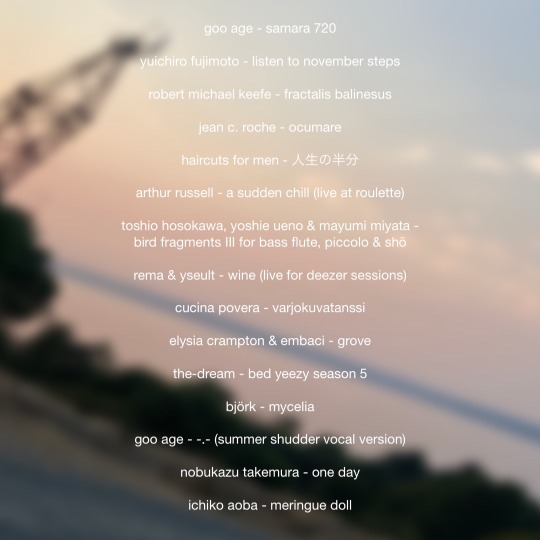
tracklist from my virgo mix 🌾
#music#goo age#yuichiro fujimoto#robert michael keefe#jean c. roche#haircuts for men#arthur russell#toshio hosokawa#yoshie ueno#mayumi miyata#rema#yseult#cucina povera#elysia crampton#embaci#the-dream#björk#nobukazu takemura#ichiko aoba
3 notes
·
View notes
Text
24 Days of La Fayette: December 9th - Comte de Charlus
Armand-Charles-Augustin de La Croix de Castries, comte de Charlus was a French nobleman that served as a Colonel en Second in the Saintonge Regiment. The Regiment was founded as the 85e Regiment of the Line in 1684. In 1780, during the Revolutionary War it was dispatched to the former colonies under the command of the comte de Rochembeau and participated in the battle of Yorktown. After the French Revolution, the regiment was transformed into the 82e Regiment of Infantry.
Charlus was born on May 23, 1756 as the oldest son of Charles Eugène Gabriel de La Croix de Castries, marquis de Castries (1727-1801) and Gabrielle Isabeau Thérèse de Rosset. Castries served as Secretray of the French Navy from 1780 until 1787. He was made a Marshal of France in 1783.
The Marquis de Chastellux described Charlus career and character as follows in a letter to George Washington from January 12, 1781:
Count de Charlus the son of marquis de Castries our new minister is a young gentleman endowed with the best and most amiable qualities, but i may do him justice in a word by saying that he is a worthy friend to marquis de la fayette. he resigned a colonelship at home to serve in America and left in france a very handsome lady whom he had married the month before. I hope that he will testify to your excellency the respect and the attachment of the whole french army (…).
"To George Washington from François-Jean de Beauvoir, marquis de Chastellux, 12 January 1781,” Founders Online, National Archives, [This is an Early Access document from The Papers of George Washington. It is not an authoritative final version.] (09/09/2022)
Charlus had already been a friend of La Fayette when he came over with his regiment, but their relationship deepened after Charlus offered his service as a volunteer aide-de-camp in March of 1781. The comte de Charlus joined La Fayette along with the comte de Dillon and the comte (?) de Sainte-Maime. All three men were friends of La Fayette and joined him in order to support his expedition against Benedict Arnold in Virginia. It appears that only Charlus served directly as an aide-de-camp. By April of the same years, the three men had left Virginia for Rhode Island, making Charlus’ service a rather short one.
La Fayette wrote in a letter to George Washington dated February 24, 1781:
Count de Ste Mîme and Mons. de St Victor are with me-- They ask Your permission to follow me and so will Count de Charlus &c. -- I told them that You would Have No objection to it As far as may Be Consistent with their Arrangements with Count de Rochambeau upon which You will not Intrude, and that the American Army will Be Happy in all times to Be Honor’d with the visit of Such Volonteers-- But these Expressions will still do Better from You, and the word Volonteer must not Be forgotten for Reasons obvious in any thing You’ll order me to Answer to them.
"To George Washington from Marie-Joseph-Paul-Yves-Roch-Gilbert du Motier, marquis de Lafayette, 24 February 1781,” Founders Online, National Archives, [This is an Early Access document from The Papers of George Washington. It is not an authoritative final version.] (09/09/2022)
La Fayette described the whole situation further in a letter to the Prince de Poix from August 24, 1781:
You will already have learned that Charlus came to Virginia with me. He had permission to travel, but they compelled him to return nonetheless, an event that has not affected him very much.
Idzerda Stanley J. et al., editors, Lafayette in the Age of the American Revolution: Selected Letters and Papers, 1776–1790, Volume 4, April 1, 1781–December 23, 1781, Cornell University Press, 1981, p. 356-349.
La Fayette and Charlus were reunited for the Battle of Yorktown although they were not directly serving together. We have previous letters where La Fayette expresses his warm feelings for Charlus but his letter from October 20, 1781 is my favourite example of these warm feelings. La Fayette wrote to the Prince de Poix:
I become more and more attached to Charlus. To the distinguished qualities that make him esteemed, he joins all those that make him loved. (…) Charlus, the vicomte, Damas, and I live as intimately together as in Paris.
Idzerda Stanley J. et al., editors, Lafayette in the Age of the American Revolution: Selected Letters and Papers, 1776–1790, Volume 4, April 1, 1781–December 23, 1781, Cornell University Press, 1981, p. 424-425.
Shortly after the Battle of Yorktown, Charlus returned to France where his military career continued to thrive. La Fayette wrote in a letter to George Washington on January 18, 1782:
Charlus is adjutant General of the Gendarmerie of France Which his Father Commands.
"To George Washington from Marie-Joseph-Paul-Yves-Roch-Gilbert du Motier, marquis de Lafayette, 18 January 1782,” Founders Online, National Archives, [This is an Early Access document from The Papers of George Washington. It is not an authoritative final version.] (09/09/2022)
The Marquis mentioned Charlus career again in a letter to George Washington from May 24, 1786:
Count de charlus, now Called duke de Castries, is Commander in second of the Gendarmerie which is Commanded by His father.
“To George Washington from Lafayette, 24 May 1786,” Founders Online, National Archives, [Original source: The Papers of George Washington, Confederation Series, vol. 4, 2 April 1786 – 31 January 1787, ed. W. W. Abbot. Charlottesville: University Press of Virginia, 1995, pp. 71–73.] (09/09/2022)
Their apparent closeness should make for a great friendship between La Fayette and Charlus, should it not? Well, let me introduce you to a little something called the French Revolution.
Charlus was initially quite positive towards the Revolution and even supported the abolishing of privileges for the nobility – at heart he however remained the most astute royalist. It did not took him and La Fayette too long to clash over the politic of the Revolution. Charlus even duelled Charles Lameth, the brother of Alexandre Lameth, La Fayette’s fellow prisoner. Lameth was slightly wounded during the duel.
Charlus fled to Coppet in Switzerland where he had family and joined the Armée des émigrés in 1794 and founded his own regiment. He only returned back to France after the Restauration in 1814. He died on January 19, 1842.
Charlus had a younger sister, Adélaïde Marie de La Croix de Castries, who married the Vicomte de Mailly in 1767. He had been married twice and each marriage produced one surviving son. He was succeeded by his first born son, Edmond Eugène Philippe Hercule de La Croix de Castries.
#24 days of la fayette#marquis de lafayette#la fayette#french history#american history#american revolution#french revolution#letter#history#lafayette's aide-de-camps#comte de charlus#george washington#founders online#marquis de chastellux#1781#1782#1786#1842#1756
9 notes
·
View notes
Text
Thurs[day] 21 August 1834
..
9 3/4
L
get on as fast in the night as day – n[o]t long[e]r in chang[in]g horses – fine, b[u]t dull, cool morn[in]g – th[e]re h[a]s
been a gr[ea]t deal of r[ai]n ver[y] recent[l]y – it preced[e]d us last night – the dust qui[te] laid even fr[om] M[on]targis –
on[l]y one postill[io]n for our 4 horses all the way fr[om] Nemours to Essonne, th[e]n 2 ag[ai]n – want[e]d to be
p[ai]d the sa[me] as if 2; b[u]t, tho’ I profess[e]d to gi[ve] 2/. p[e]r p[ai]r dur[in]g the night, I w[oul]d n[o]t do th[i]s, and on[l]y ga[ve] h[i]m 3/. p[e]r p[air]
at 7 1/2 sm[all] drizzl[in]g r[ai]n – Fr[om] Fontainebleau, the count[r]y, tho’ neith[e]r beaut[iful] n[o]r pict[uresque], improves – good
lit[tle] towns or vil[lage]s – good maison de campagne – evid[entl]y appr[oa]ching the capit[a]l – at Villejuif at 9 53/..
and off ag[ai]n at 10 – a dirtyish look[in]g goodish 1 st[ree]t vil[lage] – Fine view of Paris, and Montmartre,
en sort[an]t de Villejuif – the day clears a lit[tle] and the sun app[ea]rs – traces of a gr[ea]t deal of r[ai]n here in the
night – Pass the barr[ie]r int[o] Paris at 10 29/.. – pass[e]d by the r[ue] S[ain]t Vict[oi]re n°27 – sev[era]l let[ter]s 15
days, and s[e]nt immed[iatel]y to Geneva! how terrib[l]y unlucky – the wom[a]n s[ai]d I h[a]d prom[ise]d to wr[ite] and say
when no mo[re] were to be forward[e]d – I do rememb[e]e so[me]th[in]g of th[i]s, b[u]t nev[e]r th[ou]ght of it till th[i]s
inst[an]t – How unlucky! – Alight at Meurices’ at 11 1/4 – noth[in]g b[u]t a sm[all] 3me – lit[tle]
sitt[in]g r[oo]m and bedr[oo]m and 1 ver[y] sm[all] pl[a]ce for Eugenie – ta[ke] it – a lit de sangle put up in
the bedr[oo]m for A- [Adney] w[oul]d n[o]t tell the pr[ice] - br[eak]f[a]st at 11 5/.. – wash[e]d and dress[e]d – and wr[ote] 1 end and finish[e]d
A-‘s [Adney] let[ter] to my a[un]t writ[ten] at Clerm[on]t – afr[ai]d we sh[oul]d n[o]t get off fr[om] Paris till Mon[day] – will
wr[ite] a few lines fr[om] Lond[on] – wr[ote] also to ‘Monsieur Monsieur le directeur de la poste
aux lettres, à Genèva, Swisse’ begg[in]g h[i]m to forw[ar]d mine and A-‘s [Adney] let[ter]s to me aux soins de
Mess[ieu]rs Laffitte and c°, bankers Paris – A- [Adney] and I out at 4 – walk[e]d immed[iatel]y to the gr[ea]t poste
aux let[tre]s r[ue] Jean Jacques Rousseau – too late for let[tre]s affranchis – the off[i]ce closes at 4 –
b[u]t put in the let[ter] (vid[ere] 5th line ab[ov]e) to Geneva – saw the hall an bled (inter[io]r and walk[e]d all r[ou]nd it) –
saw als[o] the ch[ur]ces de S[ain]t Eustache and S[ain]t Roch, and call[e]d and ask[e]d M[ada]me Contant ab[ou]t Edredon –
n[o]t m[u]ch the bet[ter] for th[a]t – ord[ere]d one (w[oul]d ta[ke] 2 1/2lb. Edredon at 28/. p[e]r lb. (us[e]d to be on[l]y 25/.) to be
116fr. – ho[me] at 7 10/.. – din[ner] at 7 1/2 – ver[y] fine day – F[ahrenheit] 71° at 9 35/.. p.m. neith[e]r of us the
worse for being up all night –
4 notes
·
View notes
Text
Top 10 musiques haitiennes populaires
semaine du 4 au 10 juin 2023
Top 10 semaine 11 juin 2023
1
Touche JeziVanunca Paulcin C -
Touche JeziVanunca Paulcin C
Vues 1 | TWP 1 | LWP 1
Album
Producteur
Directeur
Cast
0
4
Description
2
YahwehTaliana Lindor -
YahwehTaliana Lindor
Vues 1 | TWP 2 | LWP 6
Album
Producteur
Directeur
Cast
0
0
Description
3
OU soti lwen avèm JeziClerveau Lovenson -
OU soti lwen avèm JeziClerveau Lovenson
Vues 1 | TWP 3 | LWP 2
Album
Producteur
Directeur
Cast
0
0
Description
4
Ansyen Roch la Pasteur Claude Louissaint -
Ansyen Roch la Pasteur Claude Louissaint
Vues 1 | TWP 4 | LWP 0
Album
Producteur
Directeur
Cast
0
0
Description
5
Mèsi BondyeTABITHA JEAN BAPTISTE -
Mèsi BondyeTABITHA JEAN BAPTISTE
Vues 1 | TWP 5 | LWP 0
Album
Producteur
Directeur
Cast
0
0
Description
6
Pouki ou renmen m konsa – Caleb BATAILLE -
Pouki ou renmen m konsa – Caleb BATAILLE
Vues 1 | TWP 6 | LWP 0
Album
Producteur
Directeur
Cast
0
0
Description
7
SE MWEN KI KANTIK LAAmmiel Rosilien ft Samuel Robuste, Yvon Elort -
SE MWEN KI KANTIK LAAmmiel Rosilien ft Samuel Robuste, Yvon Elort
Vues 1 | TWP 7 | LWP 5
Album
Producteur
Directeur
Cast
0
0
Description
8
anba zèl ouEdouard Ralph -
anba zèl ouEdouard Ralph
Vues 1 | TWP 8 | LWP 6
A
lbum
Producteur
Directeur
Cast
0
0
Description
9
The Blessing cover in Haitian creoleRodberry Jacques -
The Blessing cover in Haitian creoleRodberry Jacques
Vues 1 | TWP 9 | LWP 9
Album
Producteur
Directeur
Cast
0
0
Description
10
Kris ap viniAlmesonne Dumarsais ft. Frè Olyns Louis -
Kris ap viniAlmesonne Dumarsais ft. Frè Olyns Louis
Vues 1 | TWP 10 | LWP 4
Album
Producteur
Directeur
Cast
0
0
Description
0 notes
Text
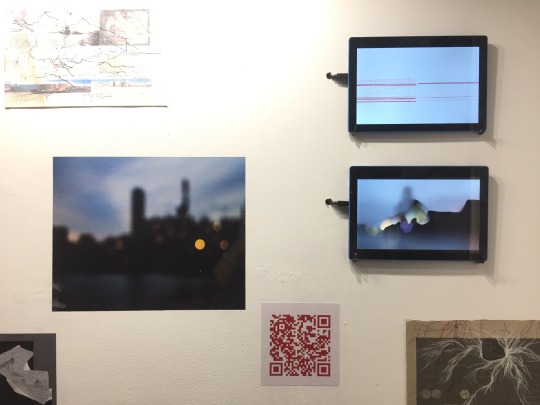
Contribution de WUJUD à l'Installation du projet Plastigo à la Vitrine de la galerie Art-Cade sur une invitation du collectif DEUX BIs. Juillet 2022. Marseille.
Projet @plastigo.project réalisé par @par_ce_passage_infranchi
Avec les artistes
Patrycja PLICH (Pologne, plasticienne) | Christophe GALATRY (Marseille, photographe) |Souad MANI (Tunisie, artiste trans-media), accompagnée de Romain PAPION (Nantes, réalisateur arts numériques) | Philippe AUTRIC, (Marseille, vidéaste)
Texte Matthieu Duperrex, Philosophe, co-fondateur et directeur artistique d' @urbain_ trop URBAIN
Comme les Modernes sont prodigues en matières inédites et en nouveaux sols ! La moindre promenade de plage nous fera dénicher des roches inattendues : un polystyrène d’ébène, une canette Saint-Jacques rouillée, des galets pneumatiques, un cristal de pétrole brut pétrifié, des tessons de terre cuite, des ciments méridionaux… Et parmi ces rebuts détritiques de l’activité humaine figurent en bonne place ces concrétions hybrides que l’on appelle « plastiglomérats ».
Technofossiles, alliages et matériaux polymères se disputent la préséance pour devenir les nouvelles pierres de rosette des stratigraphes qui cherchent à établir dans les couches sédimentaires cette nouvelle époque géologique « humaine, trop humaine » que l’on nomme Anthropocène, bien que nombre d’appellations alternatives se disputent ce sacre : Capitalocène, Plantationocène, Chthulucène, Écocène, Plasticocène… On a d’ores et déjà produit assez de plastique pour envelopper quatre fois la Terre de film d’emballage – l’émergence de cette Plastic Blue Marble a inspiré de nombreux artistes à l’interface de l’écologie et de la technologie.
L’originalité du projet « Plastigo » est d’interroger cette matérialité de l’époque au travers des technologies de capteurs : quelle science de la mesure pour des phénomènes écologiques qui configurent plastiquement l’air, le sol et l’eau ? Avec le Golfe de Fos et l’étang de Berre pour « zone critique » d’élection, P. Plich, S. Mani, P. Autric et C. Galatry se positionnent en artistes-enquêteurs entreprenant de révéler des plasticités paradoxalement invisibles, fantômes et monstres de l’Anthropocène auxquels nous familiariser, parfois malgré nous, pour continuer de vivre dans des milieux altérés. Ce faisant, ces artistes se rattachent au courant du « Sensory Art » qui explore savamment et poétiquement l’environnement au moyen de nouveaux épidermes : Rasa Smite & Raitis Smits (Fluctuations of Microworlds, 2017), Aline Veillat (Pas de deux en vert et contre, 2009-2012), Theunis Karelse (Assisted migration, 2013), Pinar Yoldas (An Ecosystem of Excess, 2014), Ivan Henriques (Symbiotic Machine, 2014), etc.
Par le dispositif qu’il propose, les activités de transcodage et de marquage qu’il met en scène, le projet « Plastigo » réinvente le territoire tel que le définissent Deleuze et Guattari, à savoir comme relevant de l’acte : « le territoire est en fait un acte, qui affecte les milieux et les rythmes, qui les “territorialise”. Le territoire est le produit d’une territorialisation des milieux et des rythmes.1
1 Gilles Deleuze et Félix Guattari, Mille plateaux. Capitalisme et Schizophrénie 2, Éditions de Minuit, coll.
« Critique », Paris: 1980, p. 386.
*Docteur en arts plastiques, Matthieu Duperrex est chercheur associé au LLA-Créatis (EA 4152), Université de Toulouse-Jean Jaurès. Artiste-auteur, co-fondateur et directeur artistique du collectif « Urbain, trop urbain » (www.urbain-trop-urbain.fr), ses travaux procèdent d’enquêtes de terrain sur des milieux anthropisés et croisent littérature, sciences humaines et arts visuels ou numériques. Publications : Shanghai Nø City Guide (Toulouse, Urbain, trop urbain, 2012), Micromegapolis, lorsqu’une ville rencontre Gaïa (Toulouse, Urbain, trop urbain, 2013), Périphérique intérieur (Marseille, Wildproject, 2014), Voyages en sol incertain, enquête dans les deltas du Rhône et du Mississippi (Marseille, Wildproject, 2019).
0 notes
Photo

Pétra - Jordanie
Pétra, « rocher » est une cité nabatéenne située au sud de l'actuelle Jordanie. C'est le pôle touristique majeur de ce pays. Fondée vers la fin du VIIIe siècle av. J.-C., par les Édomites, elle est ensuite occupée vers le VIe siècle av. J.-C. par les Nabatéens qui la font prospérer grâce à sa position sur la route des caravanes transportant l'encens, les épices et d'autres produits précieux entre l'Arabie du Sud, l'Égypte, la Syrie et la Méditerranée.
Pétra a abrité à son apogée, vers l'an 50, jusqu'à 25 000 habitants. Vers le VIIIe siècle, la modification des routes commerciales et plusieurs séismes entraîneront l'abandon progressif de la ville. Tombé dans l'oubli à l'époque moderne, le site est redécouvert en 1812 par le monde occidental grâce à l'explorateur suisse Jean Louis Burckhardt. Les nombreux bâtiments, dont les façades monumentales ont été directement taillées dans la roche, en font un ensemble unique qui est inscrit, depuis le 6 décembre 1985, sur la liste du patrimoine mondial de l'UNESCO. La zone autour du site est en outre, depuis 1993, un parc national archéologique. L'érosion, les pluies et le tourisme — en progression constante depuis la fin du XXe siècle — sont cependant une menace pour la préservation du site et des actions sont entreprises pour enrayer la destruction des monuments. Les communautés locales bédouines, les Bedul, sont intégrées de manière participative à la préservation du site de Pétra et à l'économie du tourisme.
Pétra est située à mi-chemin entre le golfe d'Aqaba et la mer Morte à une altitude de 800 à 1 396 mètres au-dessus du niveau de la mer, dans un fond de vallée de la région montagneuse d'Édom, à l'est de la vallée de l'Arabah. Le site de Pétra se trouve à près de 200 kilomètres au sud d'Amman, capitale actuelle de la Jordanie, soit à environ 3 h de route. La situation de Pétra, dissimulée entre des rochers aux parois abruptes et dotée d'un approvisionnement sûr en eau, en fait un lieu propice au développement d'une cité prospère, comme étape du commerce caravanier. L'endroit n'est accessible par le nord-ouest que par un étroit sentier montagneux ou à l'est par l'accès principal, le Sîq, un canyon d'environ 1,5 kilomètre de long et jusqu’à 200 mètres de profondeur qui, à son endroit le plus resserré, mesure seulement deux mètres de large. La présence d'eau et la sécurité apportée par le site ont fait de Pétra une halte naturelle au croisement de plusieurs routes caravanières qui reliaient l'Égypte à la Syrie et l'Arabie du Sud à la Méditerranée, chargées principalement de produits de luxe (épices et soie en provenance d'Inde, ivoire en provenance d'Afrique, perles de la Mer Rouge, turquoise du Sinaï, résine de Boswellia (l'« arbre à encens ») et encens du sud de l'Arabie).
Pétra est un site localisé dans un cirque rocheux structuré par plusieurs failles creusées par des wadis, qui constituent les principales voies de communication. L'axe principal est le wadi Mousa, qui traverse le site d'est en ouest, d'abord dans la gorge du Sîq (« le fossé ») située à l'est, dont l'entrée, précédée par les « tombeaux Djinns », était surmontée d'une grande arche aujourd'hui effondrée. Ce défilé, traversant le massif du Khubtha, constituait la voie d'accès principale pour parvenir à Pétra, et avait été dallé dans l'Antiquité.
À partir de sa sortie, où se trouve la Khazneh, l'espace s'élargit. À cet endroit se trouvent de nombreux tombeaux ainsi que le théâtre. Le cours du wadi Mousa change d'orientation pour se diriger vers le nord sur quelques centaines de mètres, avant de reprendre son trajet sur un axe est-ouest, là où se trouve le centre de Pétra, avec ses principaux ensembles monumentaux. Ce secteur est défendu par des murailles sur ses flancs nord et sud plus exposés, la défense des côtés est et ouest ne posant pas de difficultés en raison de l'exiguïté des voies d'accès. La voie pavée principale du centre-ville (son cardo) suit le cours du wadi sur sa rive sud, où ont été érigés d'est en ouest les marchés antiques, des jardins et le « grand temple sud » avec son esplanade, puis une porte monumentale ouvrant sur le temple Qasr el-Bint. D'autres édifices se trouvent sur la rive nord, notamment le temple aux Lions. Au niveau de la sortie orientale du centre, le cours principal est rejoint par plusieurs wadis d'orientation grossièrement nord-sud, qui ouvrent vers d'autres parties du site où se trouvent des monuments funéraires (notamment le tombeau « Turkmaniyeh » le long du wadi Abû 'Ullaiqa) ; le sanctuaire d'Al-M'aysrah, et vers le nord-ouest le massif sur lequel est érigé le Deir (le « monastère »).
Plus bas le wadi Mousa est rejoint par un réseau de wadis venant cette fois du sud, conduisant vers d'autres parties du site, notamment le wadi al-Farasa bordé par plusieurs tombeaux. Dans sa partie haute ce wadi mène au massif d'al-Madhbah (l'« autel », aussi accessible par un escalier depuis le théâtre). Au sud-ouest du site se trouve le massif d'Umm el-Biyara, la « mère des citernes », nommé ainsi en raison des nombreux aménagements hydrauliques qui y ont été construits dans l'Antiquité, qui a livré de nombreux vestiges d'époque édomite et une nécropole nabatéenne.
0 notes
Text

https://www.fredperry.com/subculture/category/playlists/ennio-555
#personal#me#work#ennio#music#fredperry#subculture#spotify#djspeedsick#funkadelic#nerd#the prodigy#roy buchanan#bjork#larry david#jean c roche
5 notes
·
View notes
Text
Nachbarstochter zeigt ihre Fotze am Fenster
Hi, ich bin Daniel, 45 seit 14 Jahren glücklich verheiratet und Vater eines Sohnes. Ich bin 1,82 groß und durch regelmäßige Besuche im Fitnessstudio auch sportlich gebaut. Viele Kolleginnen, die mich auf der Arbeit neu kennenlernen, schätzen mein Alter wegen meiner Optik meistens auf Ende 30 bis Anfang 40. Heute möchte ich euch von meinen Erlebnissen mit einer jungen Nachbarin erzählen.
Wir wohnen seit rund 12 Jahren in einem Neubaugebiet unsere gegenüberliegenden Nachbarn hatten etwas eher als wir mit dem Hausbau begonnen und waren beide ein paar Jahre älter als meine Frau und ich. Sie hatten eine Tochter, die ebenfalls 3 oder 18 Jahre älter war als unser Sohn. Mittlerweile musste sie knappe 18 gewesen sein.
Bei einer Grillparty bei unseren Nachbarn war mir aufgefallen, dass die kleine Jill sich zu einer echten Frau entwickelt hatte. Sie hatte lange dunkle Haare, eine schlanke Figur und schöne große Brüste.
Ich schätze 75 B oder sogar C. Der knackige Arsch von Jill war zum Niederknien. Da ihre Mutter Kroatin war, hatte Sie einen leicht südlichen Touch und immer einen schönen leicht gebräunten Hautton. Ich konnte mir also vorstellen, dass die jungen Kerle bei ihr Schlange stehen würden.
Einen festen Freund hatte Jill aber meines Wissens nicht. Aber im Prinzip wollte ich auch nicht darüber nachdenken, denn ich kannte Jill ja schon seit jüngster Kindheit. Trotzdem musste ich immer wieder reflexartig auf ihre prallen Titten schauen.
Das war wohl auch meiner Frau nicht entgangen, die mich am Abend fragte, warum ich immer so auf Jill geschaut hätte.
Ich sagte ihr ganz offen, dass mir aufgefallen war, dass sich unsere kleine Nachbarin zu einer ganz schönen Rakete entwickelt hätte. Meine Frau hatte schon etwas getrunken und die Zunge saß locker. Sie sagte etwas scherzhaft… die möchtest du wohl gerne Ficken, was? Ich sagte, dass Sie spinnen würde und ich meine kleine geile Ehefrau nie eintauschen würde und ich mich schon den ganzen Abend auf einen Fick mit ihr gefreut habe. Mein Schwanz war auch schon richtig hart.
Meine Frau nahm meine Hand und führte Sie an ihre Fotze und sagte, fühl mal, ich bin auch nass. Los schieb mir deinen geilen harten Schwanz rein. Sie stieg auf mich und fickte mich ohne Umschweife durch. Sie keuchte mir ins Ohr, dass ich ihr zusätzlich den Finger in ihr enges Arschloch schieben sollte, was ich tat.
Ich kann allerdings nicht leugnen, dass ich während dem Fick mit meiner Frau auch daran dachte, wie geil es sich wohl anfühlen würde, in den Löchern unserer jungen Nachbarin zu stecken. Das machte mich mega an. Ich wechselte die Stellung und nahm meine Frau von hinten, packte sie mit einer Hand an der Hüfte. Die andere Hand legte ich auf ihren prallen Arsch und drückte meinen Daumen fest in ihre Rosette.
Ich fickte immer wilder und meine Eier klatschten heftig gegen ihre nasse Spalte. Meine Frau und ich kamen gleichzeitig. Wir beide hatten einen mega Abgang, wobei ich mir fast die ganze Zeit nur die Fotze der jungen Nachbarin vorgestellt hatte. Hierfür schämte ich mich irgendwie und ich versuchte die Geschichte aus dem Kopf zu bekommen.
Doch das sollte nicht leicht werden.
Mein Büro lag direkt ggü. von Jill's Zimmer mit großen Bodentiefen Fenstern. Aber eigentlich war ich nicht oft in unserem Büro und die größte Zeit blieb das Büro daher dunkel und unbenutzt.
Jill, die man gut auf ihrer Couch beim Fernsehen beobachten konnte, sah ich eigentlich nur hin und wieder beim Runterziehen. Nur mit einem Top und einem Slip bekleidet lümmelte sie sich häufig auf ihrer Couch vor ihrem Fernseher, der seitlich in einer Ecke neben dem Fenster stand. Wenn Sie mich beim Runterziehen entdeckte und Licht in meinem Büro sah, winkte Sie freundlich. Da unsere Häuser nicht sehr weit auseinander lagen, konnte man alle wichtigen Details auch recht gut erkennen und man sah, dass Sie meistens Calvin Klein Slips und manchmal auch Tangas trug.
Das man sie sehen konnte, störte Jill offenbar nicht.
Eines Nachmittags im April machte ich an einem Sonntag die Steuern in meinem Arbeitszimmer während meine Frau mit unserem Sohn die Schwiegereltern besuchte. Unsere Nachbarn tranken Kaffee im Wohnzimmer. Auch das konnte ich gut sehen.
Jill schaute offenbar wieder locker bekleidet TV und winkte mir kurz zu. Anschließend war ich total vertieft in unsere Steuererklärung. Als ich nach etwa zwei Stunden mal wieder meinen Blick vom Bildschirm abwendete, traute ich meinen Augen nicht. Da saß Jill breitbeinig auf der Couch, hatte kein Oberteil mehr an und masierte ihre prallen Brüste.
Eine Hand wanderte dabei immer wieder in Richtung ihres Slips. Sie schien total vertieft zu sein, denn Sie wusste ja eigentlich dass ich im Büro war. Mein Schwanz war sofort mega hart und ich konnte nicht mehr wegschauen. Jills Hand wanderte jetzt immer häufiger zwischen ihre Schenkel und sie zog den Slip zur Seite, um mit ihren Fingern tief in ihre Fotze zu ficken.
Jetzt stand sie auf, zog den Slip aus und setzte sich mit weit gespreizten Beinen wieder auf die Couch. Ich konnte erkennen, dass sie einen akurat rasierten schwarzen Strich über ihrem Loch trug. Ihre junge Fotze hingegen war glatt rasiert. Sie rieb immer wilder an ihrer Klitoris und leckte sich zwischendurch ihren eigenen Lustsaft von den Fingern.
Ich hatte wie in Trance meinen schon mit Lusttropfen benetzten Schwanz aus meiner Jeans befreit und wichste meinen harten Prügel, während ich vor dem Fenster in unserem Büro stand. Auch ich probierte meine Lusttropfen, die wirklich gut schmeckten. Ich stellte mir vor, dass ich mit dem jungen Ding gemeinsam wichsen würde. Gerne hätte ich natürlich mal ihre Fotze berührt oder den Duft ihrer Möse gerochen.
Jetzt konnte ich nicht mehr und wichste meinen Prügel so wild, dass ich eine unglaubliche Samenladung gegen die Scheibe unseres Büros spritze. Auch Jill kam jetzt anscheinend und öffnete ihre Augen mit Blick in mein Büro. Sie blieb noch eine Weile mit ihrer offenen Fotze vor dem Fenster sitzen und verschwand dann aus meinem Sichtfeld. Mit Mühe und Not befreite ich die Fensterscheibe von meinem Saft, bevor meine Frau mit meinem Sohn von den Schwiegereltern zurückkehrte.
Ich hoffte, dass die junge Nachbarstochter mich nicht gesehen hatte. Allerdings hatte ich die Befürchtung, dass mein 26 cm langer Schwanz mit fast 6 Durchmesser kaum zu übersehen war.
In den darauffolgenden Wochen und Monaten ging ich immer
öfters in unser Büro, wenn ich alleine war und hatte noch häufiger die Gelegenheit, Jill bei der Masturbation zu beobachten und mich dabei selbst zu befriedigen. Doch das musste aufhören, denn ich konnte nur noch an das kleine Luder denken.
Zum Glück fuhr Jill am nächsten Tag mit ihren Eltern in den Urlaub.
Morgens schlich ich mich daher ganz früh in Mein Büro und hoffte nochmal einen Abschiedsblick auf das heiße Loch meiner jungen Nachbarin werfen zu können. Und so war es, Jill lehnte über ihre Couch und präsentierte mir ihren perfekten Arsch zog, den Slip zur Seite und fickte mit einem großen Dildo ihre pulsierende Fotze. Ihre nasse Spalte hatte einen großen feuchten Fleck an der Stelle ihrer nassen Pussy hinterlassen. Ich hätte mich gerne entladen, aber ich war leider nicht alleine im Haus.
Echt schade! Jetzt wollte ich Jill vergessen und sie zukünftig auch nicht mehr beobachten.
Jill und ihre Eltern fuhren wenige Minuten später in den Urlaub und ich stellte mir vor, dass Jill sich mit diesem geilen Anblick auch noch von mir verabschieden wollte. Plötzlich klingelte das Telefon und unser Nachbar Heiko, der Vater von Jill, war am Telefon. Hatte er mich etwa gesehen. Er klang genervt und sagte, du wir sind gerade 5 Minuten unterwegs und unsere Tochter hat ihren Fernseher angelassen.
Da wir gegenseitig einen Schlüssel von uns hatten und auf unsere Häuser während des Urlaubs Acht gaben, bat er mich den Fernseher von Jill aus zu machen. Ich ging in unser Schlafzimmer und erzählte meiner Frau, die noch schlummerte, von dem Missgeschick von Jill und dass ich kurz rübergehen würde. Meine Frau schlief wieder ein. Im Zimmer von Jill angekommen, roch noch alles nach ihr und irgendwie roch es auch geil nach Fotze und Arsch, meinte ich zumindest.
Da ihre Rollos halb heruntergelassen waren, konnte ich alles genau inspizieren, ohne Gefahr zu laufen, dass meine Frau oder mein Sohn mich hätten aus unserem Haus sehen können. In der Ecke neben dem Fernseher stand ein Stativ mit Beleuchtung, wo man das Handy oder ein Tablet für Selfie-Aufnahmen integrieren konnte. Jill war anscheinend der Fotografie und Filmerei sehr zugetan, denn in ihrem Zimmer lagen in einer Vitrine diverse Kameras. Zu meiner Verwunderung war der Fernseher nicht an.
Aber es klebte ein Post-It am TV. Hierauf standen 3 Wörter mit einem Smiley… USB, Ordner Favoriten. Ich schaltete den Fernseher ein, suchte den Ordner im USB Laufwerk und öffnete den Ordner, der auf dem Zettel stand. Im Ordner gab es eine Datei, die Lieblings-BWC hieß.
Ich setzte mich auf die Couch. Auf der Couch lag der nasse Slip von Jill, den Sie gerade noch trug. Ich presste meine Nase an den Slip. Das roch so geil, dass mein Schwanz sofort aktiviert war.
Ich faltete den Slip auseinander und leckte an dem leicht salzigen Necktar ihrer Fotze, der sich noch im Slip befand. Beim Blick auf dem Fernseher stockte mir aber dann der Atem.
Jill hatte mich tatsächlich beim Wichsen gefilmt und mit einer Kamera meinen Schwanz ganz nah herangezoomt. Mist, sie hatte mich gesehen und gefilmt.
Jetzt wollte sie mich bestimmt erpressen. 1000 Gedanken und Ängste schossen mir durch den Kopf.
Doch im nächsten Moment teilte sich der Bildschirm und Jill kam auf der anderen Hälfte ins Bild. Die kleine Sau war nackt und hatte wahrscheinlich mit ihrem Selfie Stativ einen Film gedreht, wie Sie sich selbst die Fotze massiert während ich meinen Schwanz im Büro bearbeitete. Offenbar waren ihre Eltern nicht, da, als Sie das Video drehte, denn Sie stöhnte laut bei jeder Berührung ihrer triefend nassen Spalte.
Sie rief, ja, bitte wichse deinen geilen dicken, mega Schwanz für mich und spritz deine geile Ficksahne überall hin. Ich würde dich so gerne selbst ficken du geiler Hengst. Dann rieb Sie immer wilder an Ihrer Clit und spritzte etwas Flüssigkeit aus ihrer Fotze. Sie schien mehrere Orgasmen zu haben und ihr Körper und ihre Fotze zuckten wild.
Beim näheren Betrachten der Couch sah man auch ein paar eingetrocknete Flecken. Dann spritzte auch ich im Video meine Ladung ab. Jill massiert sich im Video noch etwas weiter ihre geschwollenen Schamlippen und sagte immer wieder. Ich will diesen großen Schwanz jetzt endlich mit all meinen Löchern verwöhnen oder zumindest mal seine Ficksahne schmecken.
Dann war das Video vorbei. Meine erste Verunsicherung war verschwunden. Wie in Trance roch ich an der Couch, auf der Jill gerade noch gesessen hatte und ja, die roch geil nach allen Köpersäften, Fotze und Arsch. Den Slip inhalierte ich immer wieder tief ein.
Meine Hose hatte ich längst geöffnet und massierte meinen großen 26 cm Schwanz, der noch nie so hart war. Ich konnte nicht mehr und spritze ab, wobei ein Teil auf der Couch landete. Aber hier waren ja ohnehin schon Flecken drauf. Also egal.
Jetzt musste ich aber wieder zurück nach Hause bevor meine Frau aufwachen würde.
Ich bekam das Erlebte natürlich nicht mehr aus dem Kopf und wann immer ich konnte, ging ich während des Urlaubs zur Blumenpflege und zur Leerung des Briefkastens zu unseren Nachbarn. Ich machte mir jedes Mal den Fernseher von Jill an und rieb den Slip von Jill über mein hartes Rohr. Bei jedem Besuch kam ich mindestens 2 Mal.
Zum Abschluss spritze ich mal in ihre Unterwäsche im Nachtschrank, auf den Dildo, den ich in einer Kiste unter der Couch gefunden hatte, in ihr Bett oder in ihre Schmutzwäschetonne, in der noch mehr getragene Unterwäsche lag. Dabei filmte ich mich mit meinem Handy. Als der Urlaub zu Ende ging, legte ich legte Jill einen Zettel in die Vibrator-Box. Rate wo ich überall für dich hingewichst habe oder schau es dir einfach in deinem Lieblingsorder an :-D.
Dann kannst du evtl. noch meine Sahne irgendwo ablecken, denn ich war bis gerade noch in deinem Zimmer. Natürlich hatte ich mir das Video der geilen Teen-Schlampe auf meinem Handy und einem USB Stick gesichert. Meine Wichsorgien hatte ich Jill zudem auf ihr USB-Laufwerk des Fernsehers übertragen.
Als der Urlaub unserer Nachbarn vorbei war, fuhren wir direkt selbst im Anschluss in den Urlaub und ich versuchte die Sache zu vergessen, obwohl ich nur noch wenig Lust hatte, meine Frau zu ficken und nur noch Jill im Kopf und auf dem Handy hatte, die mich ja offensichtlich auch ficken wollte. Ob mir das Verdrängen wohl gelingt?
143 notes
·
View notes
Text
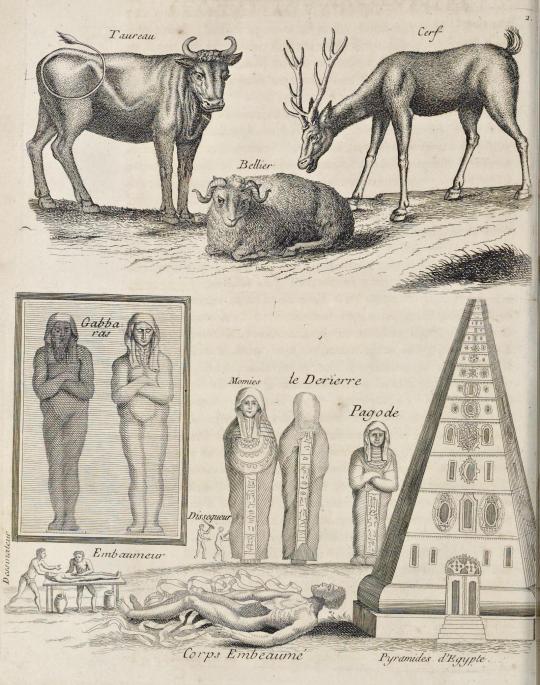

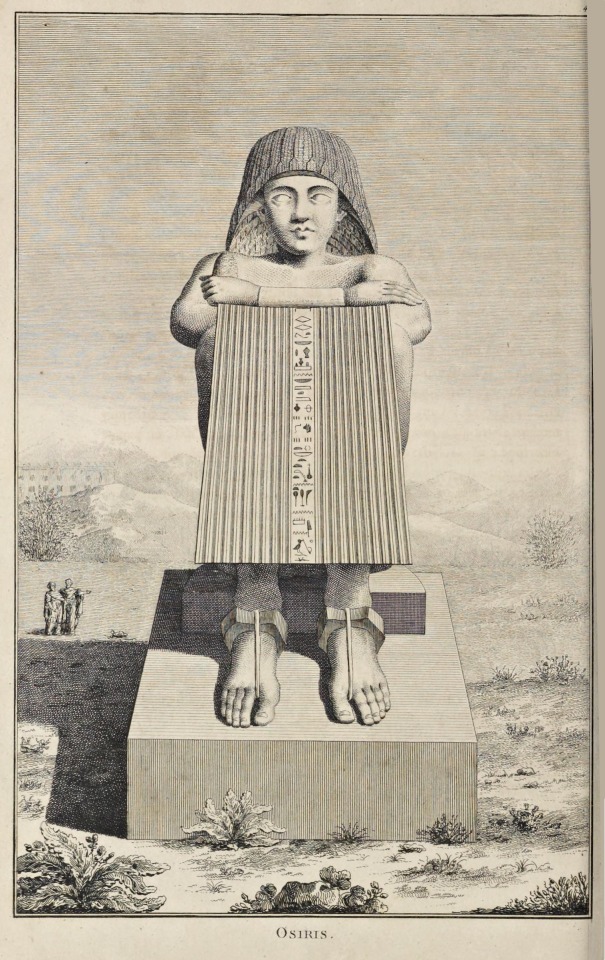
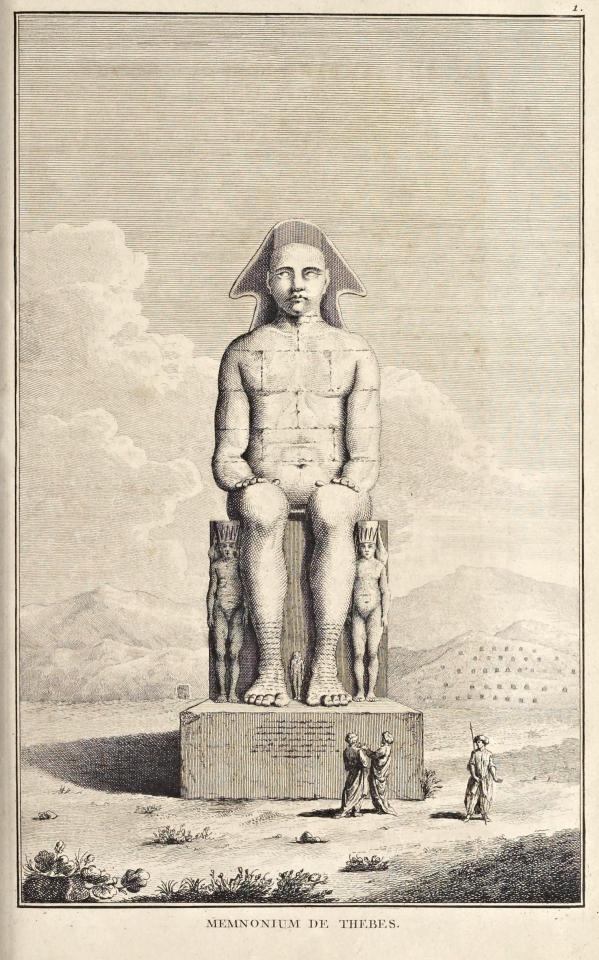
Superstitions orientales, ou, Tableau des erreurs et des superstitions des principaux peuples de l'orient
by Poncelin de La Roche-Tilhac, Jean-Charles, 1746-1828
c. 1785
5 notes
·
View notes
Photo


0014 - Hawkwoman (Kendra Saunders/Shayera Thal/Shiera Saunders)
Age: 33
Occupation: Director, adventurer.
Marital status: Single
Known relatives: Shiera Saunders Hall (great-aunt, deceased), Carter Hall (great-uncle), Cyril “Speed” Saunders (grandfather, deceased), Michael Saunders (father, deceased), Trina Saunders (mother, deceased).
Group affiliation: Justice League of America, formerly Justice Society of America.
Base of operations: Los Angeles, California, formerly St. Roch, Louisiana, New York City.
Height: 5′9″
Weight: 135 lbs.
History:
c. 1280 B.C: Princess Chay-Ara is born in Egypt.
c. 1255 B.C: Chay-Ara, along with her beloved Khufu, the wizard Nabu, and champion Teth-Adam, come across the wreckage of a Thanagarian ship, laden with the mysterious Nth metal. The two use the alien technology to bring peace to their land and build incredible wonders.
C. 1240 B.C: Khufu and Chay-Ara are murdered by the priest Hath-Set, destined to be reincarnated into new bodies.
1917 A.D: Chay-Ara is reincarnated into the body of newborn Shiera Saunders.
1940 A.D.:
Shiera meets Carter Hall, the reincarnation of Khufu, and her memories of her past lives return. She dons a costume similar to his and becomes Hawkgirl.
Hall and Saunders first encounter Dr. Anton Hastor, the modern reincarnation of Hath-Set.
The pair become founding members of the Justice Society of America, with Hall acting as their first chairman.
1941 A.D: President Franklin Roosevelt calls on Hawkgirl and the rest of the JSA to join the war effort, fighting on the home front as members of the All-Star Squadron.
1947 A.D: Hall and Saunders first encounter Jim Craddock, the Gentleman Ghost.
1951 A.D: As part of a scheme from Per Degaton, the Justice Society is called before the House Un-American Activities Commission, and forced to either reveal their true identities, or disband. Saunders, alongside many of his comrades, chooses to disband the team.
1953 A.D: Hall and Saunders are married, and have a son, Hector. They also discover the kingdom of Feithera, and adopt one of the avian humanoid natives, Norda, as their godson.
1979 A.D: Hall and Saunders are murdered by Hastor, and reincarnate as Thanagarian police officers Katar Hol and Shayera Thal.
18 years ago: Hol and Thal come to Earth, becoming members of the Justice League of America, and fast friends with Ray Palmer, the Atom.
14 years ago: Thal severs ties with Thanagar after the planet declares war on neighboring planet Rann.
10 years ago: Thal dies and Hol is gravely injured while helping to repel the invasion of Earth by an alien alliance that included Thanagarians among their number. Chay-Ara’s spirit enters the body of Kendra Saunders, Shiera’s niece, after Kendra fails to commit suicide.
7 years ago:
Attempting to avoid the destiny that people say is written out for her, Saunders joins the Justice Society, becoming romantically involved with Sanderson Hawkins.
The reborn Carter joins the new JSA as well, and successfully convinces Kendra to relocate with him to St. Roch, Louisiana. Kendra finishes her film degree at St. Roch University.
6 years ago: Kendra answers Batman’s summons to join the Justice League after the active membership vanishes to ancient Atlantis.
5 years ago:
Ray Palmer is murdered by his ex-wife, Jean Loring, under the control of Eclipso. In response, Hall nearly murders Loring in cold blood, only stopped by the intervention of Kendra.
Kendra and Carter are called upon to fight in the war between Rann and Thanagar. While Carter remains on Thanagar, Kendra returns to Earth to put some distance between the two of them.
4 years ago: Kendra moves to Los Angeles, also joining the restructured Justice League and starting a relationship with Roy Harper.
3 years ago: Carter returns to Earth, only to be swept up in the Blackest Night. He and Kendra are seemingly killed by the reanimated Black Lantern corpse of Ray Palmer, but survive thanks to the curse placed on their reincarnation.
1 year ago: Kendra reluctantly accompanies Carter when he invites her to learn the secret of their past lives together.
Present day: Kendra is offered the reins of a major motion picture, and struggles to divide her time between her job and hero work.
Commentary:
And now: Kendra “screw destiny” Saunders. I went into most of the detail on the Hawks in Carter’s post, so here I’ll be focusing on what’s unique to Kendra, her ongoing fight against the pull she feels toward Carter, which is Chay-Ara’s spirit guiding her back toward her “soulmate.”
Due to a wrench thrown into the works of Khufu and Chay-Ara’s reincarnation cycle, Kendra doesn’t have the privilege of having memories of her past lives. Being Kendra Saunders is all she’s ever known, and she doesn’t care what her fate is, she wants to live her life how she chooses, especially if that means dating other men just to spite Carter.
Kendra’s got a troubled past and a fierce independent streak as she toes the line between embracing her destiny and outright rejecting it - despite everything, she still wears a variation on Shiera’s uniform, and still finds herself by Carter’s side more often than she’d really like. Will she fall victim to fate and end up linked to him again? Only time will tell.
Next up: the Atom and Jason Woodrue!
#dc#dc comics#earth 53#profile#justice league of america#justice society of america#hawkgirl#hawkwoman#kendra saunders#shiera hall#shayera thal
23 notes
·
View notes
Text
Thick with Smallpox: The First Time Dumfries Battled an Invisible Foe and Won
By: Lisa Timmerman, Executive Director
In April 1777, Dumfries became a critical site to the Revolutionary War as physicians, troops, and new recruits headed to the town to partake in a mass inoculation of the Continental Army. Not only was disease reportedly “thick on the roads”, Congress and the Continental Army collectively held their breath has they enacted a massive daring plan to protect their Achilles heel – the troops and new recruits vulnerability to smallpox.
On 02/05/1777, Washington set in motion plans for a mass inoculation of all troops and new recruits aware of the need for urgency and secrecy. Not only was he battling against mistrust and misinformation, the variolation gave a milder form of smallpox to the recipients, making those individuals disease vectors as well. To do this, the Continental Army needed to secure space, supplies, and people to properly inoculate and quarantine each person. On 04/23/1777, Congress “Resolved, that Dr. James Tilton be authorized to report to Dumfries in Virginia, there to take charge of all Continental soldiers that are or shall be inoculated against smallpox, and that he shall be furnished with the necessary medicines.” Congress dispatched physicians across the colonies including Alexandria and Georgetown. Troops previously unexposed to smallpox and new recruits arrived in these designated areas with the army using guarded private homes and churches as inoculation and treatment centers. Joseph Robertson from Northumberland Co., Virginia, noted, “Was marched to Dumfries, where I was inoculated for the small pox, on recovering from which I was marched to Valley Forge…” By 06/02/1777, Dr. William Shippen, Jr. wrote to George Washington noting, “…to assist & direct Dr. Tilton one of our senior Surgeons who writes me he has near 1100 Carolinians, officers included, under inoculation at Dumfries, Alexandria & Georgetown; Not one of these men have been subjects of our Hospital, but are in a fine state to receive the small pox & promise fair to have that disease very lightly; owing the Dr writes to their officers great attention to the cleanliness of their men; than which nothing can more effectually secure the health of a large Army.” Merchant and Postmaster Ebenezer Hazard traveled through the region in May 1777 describing Dumfries as “a very small Place, of considerable Trade” noting that most of the North Carolina and Virginia troops were “under inoculation”. (You can read about his other unpleasant statements in a previous blog here).
Colonel William Grayson actively reported the situation to Washington requesting his approval to purchase medicines from regimental surgeon Dr. Alexander to difficulties recruiting new men during April 1777, even noting the resignation of officers. His letter to Washington on 04/22/1777 from Dumfries noted his active involvement in directing units to inoculation sites such as Colchester and Alexandria as “there being no room at this place”. Frustrating to officers was the refusal of some counties to inoculate. Lieutenant Colonel Leven Powell notified Grayson of this in Loudon County, “I applyd to our Court the other day for leave to innoculate our Soldiers for the Small Pox but without Success, as the Season is advan[c]ing fast would it not be best for them to go either to Dumfries or Alexa., I am told the Small Pox is so thick on the road to Phila. that it will [be] impossible to get there without taking it. Any Orders you shall give respecting it I will endeavour to have complyd.”
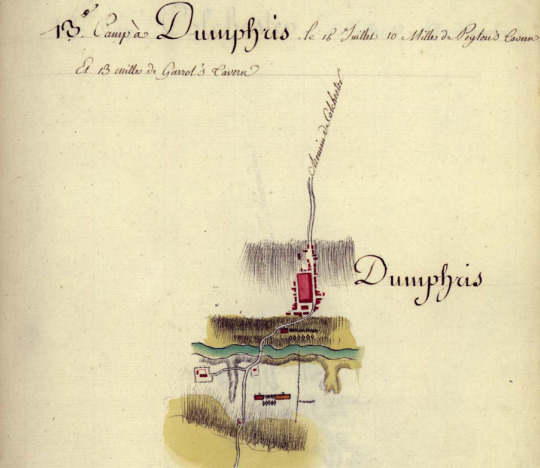
(1782 Rochambeau Map: Camp a Dumphris. “Amérique campagne". Rochambeau,Jean-Baptiste-Donatien de Vimeur, comte de, 1725-1807.1782. G1201.S3 R65 1782 Vault : Roch 67. Library of Congress Geography and Map Division Washington, D.C.)
Overall, this audacious, risky, and impressive plan prevented an uncontrolled massive smallpox outbreak that could have disabled the Continental Army at crucial moments during the Revolutionary War. Washington’s campaign took the morality rate that was upwards of 50% to less than 2%. The evidence from this along with the development of the actual vaccine led President James Madison to sign ‘An Act to Encourage Vaccination’ that created the United States Vaccine Agency and required “‘the postal service to carry mail containing smallpox vaccine materials free of charge’.” And the doctor ordered to Dumfries in April 1777? Notably, Dr. Tilton later became the Physician and Surgeon General of the U.S. Army from 1813-1815, consistently advocating for proper sanitation protocols, elimination of incompetent persons, and the importance of well-ventilated areas.
While this blog focused on Virginia and the soldiers in the Revolutionary War, the history of inoculation in America began when the enslaved person physician Cotton Mather referred to as Onesimus (his real name is unknown) explained the practice of variolation. You can read more about this incredible story here (Washington Post Link: The African Roots of Inoculation in America: Saving Lives for Three Centuries by Gillian Brockell).
Note: The Weems-Botts Museum and Lee Lansing Research Library are scheduled to reopen to the public on 05/01! Until then, you can enjoy our virtual programs such as our monthly Weems-Botts Bibliophiles. March features the history, lore, and stories of the Brothers Grimm fairy tales, featuring academic discussions and eyebrow raising morals – tickets and more info here!
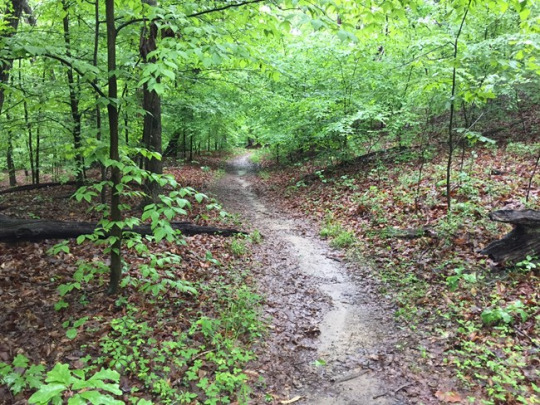
(NPS: Prince William Forest: The Crossing Trail. Used by Washington & Rochambeau but also served as a thoroughfare for Virginia)
(Sources: Fisher, Amy Lynn and Raymond Dwek. George Washington and the First Mass Military Inoculation. Library of Congress: Science Reference Services, 2009. Accessed 03/16/2021; Thacker, Brenda. Disease in the Revolutionary War. George Washington’s Mount Vernon: Washington Library. Accessed 03/16/2021; Revolutionary War: History: The Continental Army Battles an Invisible Foe. American Battlefield Trust. Accessed 03/16/2021; CDC: History of Smallpox, https://www.cdc.gov/smallpox/history/history.html; Najera, Rene F. Black History Month: Onesimus Spreads Wisdom That Saves Lives of Bostonians During a Smallpox Epidemic. The History of Vaccines: An Educational Resource by the College of Physicians of Philadelphia. Accessed 03/16/2021; Becker, Ann M. Smallpox in Washington’s Army: Strategic Implications of the Disease during the American Revolutionary War. The Journal of Military History, Vol. 68, No. 2 (April 2004): 381-430; Virginia Military Records From The VA Magazine of History and Biography, the William and Mary College Quarterly, and Tyler’s Quarterly. Baltimore: Clearfield Company, 2000; Bayne-Jones, Stanhope. The Evolution of Preventative Medicine in the United States Army, 1607-1939, Part 3: The American Revolutionary War and First Years of the Republic; Inglis, Stacey. Focusing on Firsts: Delaware Doctor was First U.S. Army Surgeon General. Delaware Medical Journal, September/October 2018, Vol. 90, No. 7:pages 248-251; “To George Washington from Colonel William Grayson, 1 April 1777,” Founders Online, National Archives, https://founders.archives.gov/documents/Washington/03-09-02-0037. [Original source: The Papers of George Washington, Revolutionary War Series, vol. 9, 28 March 1777 – 10 June 1777, ed. Philander D. Chase. Charlottesville: University Press of Virginia, 1999, pp. 35–37.]; “To George Washington from Colonel William Grayson, 8 April 1777,” Founders Online, National Archives, https://founders.archives.gov/documents/Washington/03-09-02-0089. [Original source: The Papers of George Washington, Revolutionary War Series, vol. 9, 28 March 1777 – 10 June 1777, ed. Philander D. Chase. Charlottesville: University Press of Virginia, 1999, pp. 86–87.]; “To George Washington from Colonel William Grayson, 29 April 1777,” Founders Online, National Archives, https://founders.archives.gov/documents/Washington/03-09-02-0287. [Original source: The Papers of George Washington, Revolutionary War Series, vol. 9, 28 March 1777 – 10 June 1777, ed. Philander D. Chase. Charlottesville: University Press of Virginia, 1999, pp. 299–300.]; “To George Washington from Colonel William Grayson, 22 April 1777,” Founders Online, National Archives, https://founders.archives.gov/documents/Washington/03-09-02-0222. [Original source: The Papers of George Washington, Revolutionary War Series, vol. 9, 28 March 1777 – 10 June 1777, ed. Philander D. Chase. Charlottesville: University Press of Virginia, 1999, pp. 237–238.]; NCBI: Liebowitz, Dan. Smallpox Vaccination: An Early Start of Modern Medicine in America. Journal of Community Hospital Internal Medicine Perspectives. 2017 Jan; 7(1): 61–63.)
#revolutionary war#inoculation#staysafe#vaccine#virginiahistory#localhistory#smallpox#georgewashington#military#bravery#primarysources#museumfromhome#historyathome
2 notes
·
View notes
Text
Reading de Nacht Reading 2019
my favourite books of the year
my overall favourite book of the year:
martin hägglund "this life why mortality makes us free" (2019)
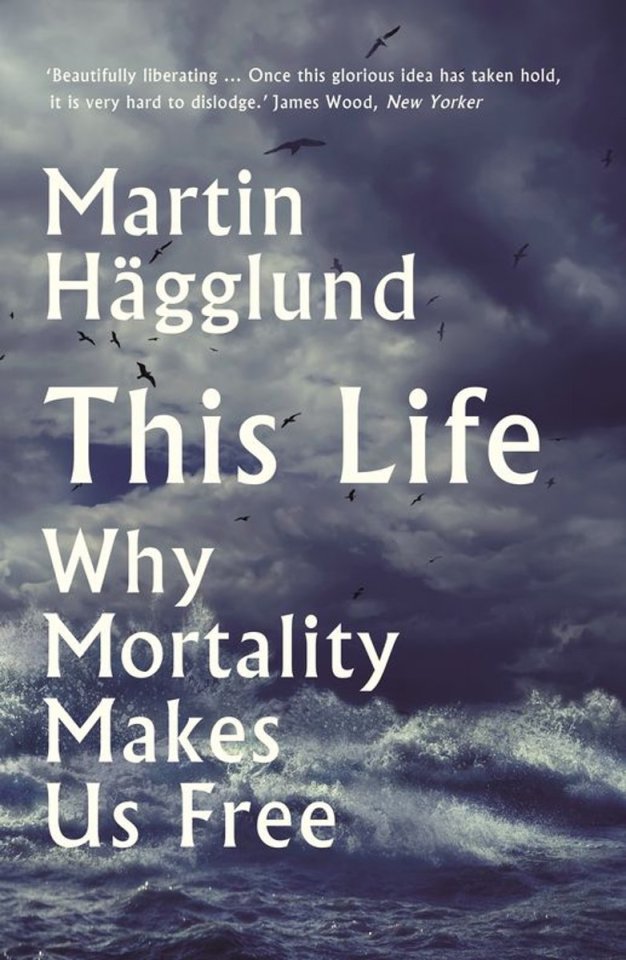
postcyberpunkstompf:
01 ken liu (ed) "broken stars: contemporary chinese sf in translation" (2019)

02 cory doctorow "radicalized" (2019)
03 dave hutchinson "the return of the incredible exploding man" (2019)
+ dave hutchinson "nomads" (2019)
+ dave hutchinson "thumbprints" (1978)
+ dave hutchinson "torn air" (1980)
+ dave hutchinson "the push" (2009)
+ dave hutchinson "the villages" (2002)
... damn that elusive "paradise equation" (1981) ...
04 tade thompson "rosewater" (2016)
+ tade thompson "rosewater insurrection" (2019)
+ tade thompson "rosewater redemption" (2019)
05 desirina boskovich (ed) "lost transmissions: the secret history of sf & f" (2019)

06 hannu rajaniemi & jacob weisman (eds) "the new voices of science fiction" (2019)
07 gardner dozois (ed) "the very best of the best: 35 years of the year's best science fiction" (2019)
08 jonathan strahan (ed) "the best science fiction & fantasy of the year, volume thirteen" (2019)
09 robert markeley "kim stanley robinson modern masters of sf" (2019)
10 allan kaster (ed) "the year's top hard sf stories 3" (2019)

11 olivier girard (ed) "bifrost 96 la revue des mondes imaginaires: william gibson" (2019)
12 mario guglielminetti "web is over. parabola ed esplosione di ubuweb, l'antiprofilo" (2019)
13 bryan thomas schmidt (ed) "infinite stars: dark frontiers" (2019)
14 baoshu "the redemption of time" [2011] (2019)
15 cixin liu "the supernova era" [2003] (2019)

16 l. x. beckett "gamechanger" (2019)
17 gareth l powell "fleet of knives" (2019)
18 chen qiufan "waste tide" [2013] (2019)
19 derek künsken "the quantum garden" (2019)
20 gregory benford "rewrite: loops in the timescape" (2019)
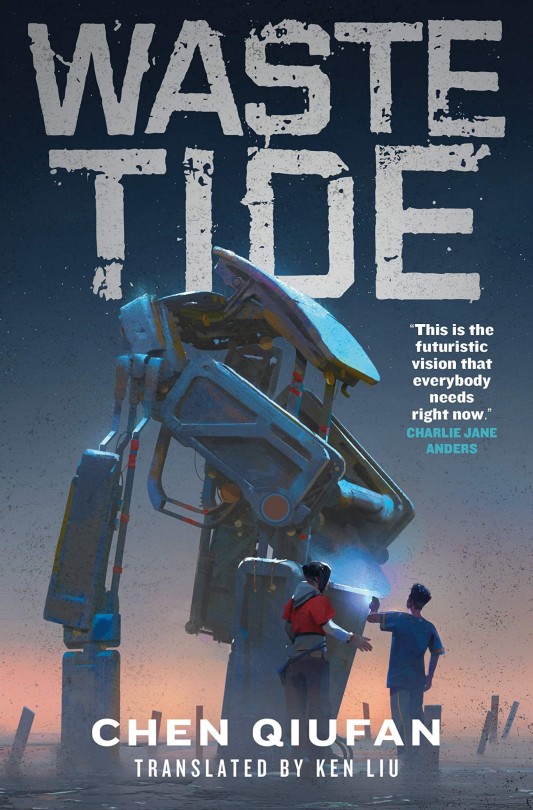
21 james s.a. corey "tiamat's wrath" (2019)
+ james s.a. corey "auberon" (2019)
22 jim al-khalili "sunfall" (2019)
23 peter f hamilton "salvation lost" (2019)
24 neal asher "the warship" (2019)
25 jonathan strahan (ed) "mission critical" (2019)

26 jack mcdevitt "octavia gone" (2019)
27 elizabeth bear "ancestral night" (2019)
28 ian mcdonald "moon rising" (2019)
29 carmen maria machado (ed) "the best american sf & f 2019" (2019)
30 valerie valdes "chilling effect" (2019)
31 simon morden "bright morning star" (2019)
+ s. j. morden "no way" (2019)
32 neil stephenson "fall or, dodge in hell" (2019)
33 graham edwards "string city" (2019)
klassikstompf:
01 arno schmidt "bottom's dream" [1970] (2016) ... & still reading ...

02 jorge luis borgès "borgès restored (the author's preferred translations)" (2016)
03 julie orringer "the flight portfolio" (2019)
+ julie orringer "the invisible bridge" (2010)
04 pola oloixarac "savage theories" (2017)
+ pola oloixarac "dark constellations" (2019)
05 simon critchley "memory theatre" (2014)

06 gabriel josipovici "hotel andromeda" (2014)
07 david keenan "for the good times" (2019)
08 wg sebald "vertigo" [1990] (1999)
+ wg sebald "the emmigrants" [1992] (1996)
+ wg sebald "the rings of saturn" [1995] (1998)
+ wg sebald "austerlitz" (2001)
09 luis chitarroni "the no variations "diary of an unfinished novel" [2007] (2013)
10 julián ríos "larva: a midsummer night's babel" [1983] (1991)

11 césar aira "birthday" [2001] (2019)
+ césar aira "three novels" [1990-2000-1997] (2018)
12 tom mole "the secret life of books" (2019)
13 lucy ives "loudermilk or the real poet or the origin of the world" (2019)
14 lászló krasznahorkai "baron wenckheim's homecoming" [2016] (2019)
15 lucy ellmann "ducks, newburyport" (2019)

16 lars iyer "nietzsche & the burbs" (2019)
17 d harlan wilson "the psychotic dr. schreber" (2019)
18 andrew gallix (ed) "we'll never have paris" (2019)
19 chris kelso (ed) "i transgress" (2019)
20 john crowley "the solitudes" [1987] (2007)
+ john crowley "love & sleep" (1994)
+ john crowley "daemonomania" (2000)
+ john crowley "endless things" (2007) ... (the aegypt cycle)

polarstompf:
01 carlos ruiz zafón "the labyrinth of the spirits" [2017] (2018)

02 volker kutscher "the fatherland files" [2012] (2019)
03 andrea camilleri "the overnight kidnapper" [2015] (2019)
+ andrea camilleri "the other end of the line" [2016] (2019)
04 mick herron "joe country" (2019)
+ mick herron "this is what happened" (2018)
+ mick herron "nobody walks" (2015)
05 john le carré "agent running the field" (2019)

06 guillaume musso "la vie secrète des écrivains" (2019)
07 luke mccallin "the man from berlin" (2013)
+ luke mccallin "the pale house" (2014)
+ luke mccallin "the divided city" (2016)
09 henry porter "brandenburg" [2005] (2019)
+ henry porter "firefly" (2018)
+ henry porter "white hot silence" (2019)
10 mitch silver "the bookworm" (2018)
+ mitch silver "in secret service" (2007)
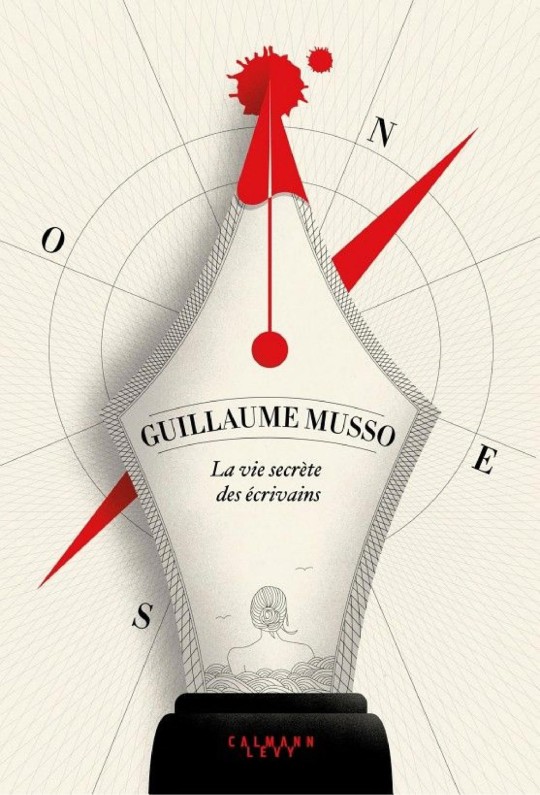
11 alan judd "the accidental agent" (2019)
12 philip kerr "metropolis" (2019)
13 ian rankin "westwind" (2019)
14 jo nesbø "the knife" (2019)
15 david hewson "devil's fjord" (2019)

16 barry forshaw "crime fiction: a reader's guide" (2019)
17 a.a. dhand "one way out" (2019)
18 martin holmén "clinch: the stockholm trilogy 01" (2016)
+ martin holmén "down for te count: the stockholm trilogy 02" (2017)
+ martin holmén "slugger: the stockholm trilogy 03" (2019)
19 michael kestemont "de zwarte koning" (2019)
20 soren sveistrup "the chestnut man" [2018] (2019)
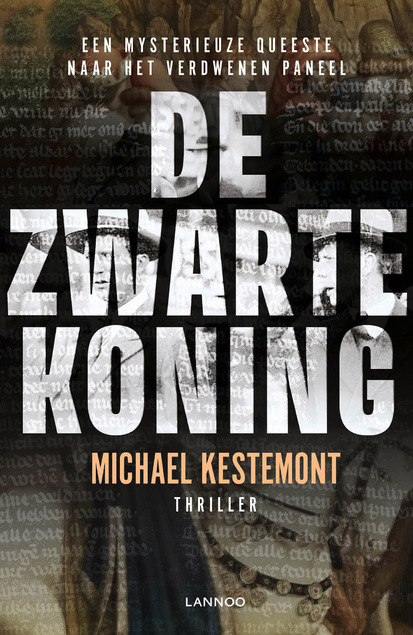
21 tim mason "the darwin affair" (2019)
22 patrick conrad "good night, charlie" (2019)
23 chris pavone "the paris diversion" (2019)
24 dov aflon "a long night in paris" (2019)
25 arne dahl "hunted" [2017] (2019)
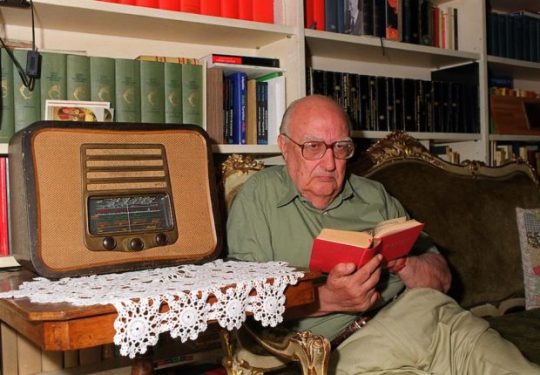
RIP ANDREA CAMILLERI !
gedächtnisstompf:
01 martin hägglund "this life: why mortality makes us free" (2019) /
"this life: secular faith & spiritual freedom" (2019)

02 derrida "la vie la mort: séminaire (1975-1976)" (2019)
03 jean-luc nancy "derrida, suppléments” (2019)
04 jean-françois bouthors et jean-luc nancy "démocratie! hic et nunc" (2019)
05 hannah arendt "de vrijheid om vrij te zijn" (2019)
+ hannah arendt "nous autres réfugiés" (2019)
06 mckenzie wark "capital is dead": is this something worse?" (2019)
07 johan schokker & tim schokker
"extimiteit: jacques lacan's terugkeer naar freud" (2000)
08 gerhard richter & ann schmock (eds) "give the word:
responses to werner hamacher's 95 theses on philology" (2019)
09 ranja n gosh "philosophy & poetry: continental perspectives" (2019)
10 shoshana zuboff "the age of surveillance capitalism" (2019)
11 kate zambrano "screen tests: stories & other writing" (2019)
12 daniele carluccio "roland barthes lecteur" (2019)
13 jean-clet martin "la philosophie de gilles deleuze" (2019)
14 mitchell dean & daniel zamora "le dernier homme et la fin de la révolution: foucault après mai 68" (2019)
15 arnon grunberg "vriend & vijand: decadentie, ondergang & verlossing" (2019)
16 kwami anthony appiah
"de leugens die ons verbinden: een nieuwe kijk op identiteit" [2018] (2019)
17 quentin meillassoux "science fiction & extro-science fiction" (2015)
18 roberto calasso "het onbenoembare verleden" [2017] (2019)
19 lydia davis "essays" (2019)
20 denise riley "time lived, without its flow" (2019)
poesisstompf:
zoë skoulding "footnotes to water" (2019)
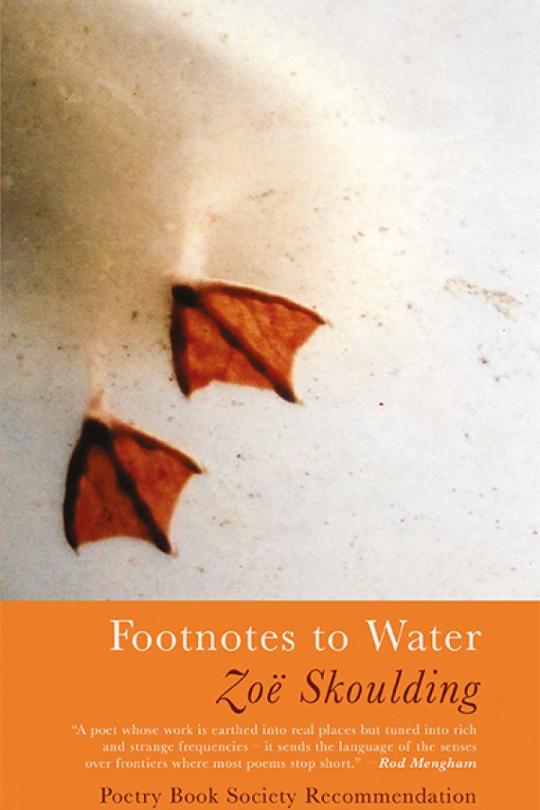
platterstompf:
01 rick moody "on celestial music, and other adventures in listening" (2012)
02 yann courtiau "frictions:
ce que la littérature a fait à la musique et ce que la musique a en a fait" (2019)
03 vivien goldman "revenge of the she-punks:
a feminist music history from poly styrene to pussy riot" (2019)
04 garrígos, triana & guerra "god save the queens: pioneras del punk" (2019)
05 jon savage "this searing light, the sun & everything else:
joy division the oral history" (2019)

06 richard beck "trains, jesus, and murder: the gospel according to johnny cash"
07 mark lanegan "sleevenotes" (2019)
08 jason williamson "jason williamson's house party: sleaford mods 2014-2019" (2019)
09 gallix, hill, & rose (eds) "love bites: fiction inspired by pete shelley" (2019)
10 greg laurie "johnny cash the redemption of an american icon" (2019)

11 marc vos & toon loenders "siglo xx:
opdat de dood ons levend vindt & het leven ons niet doodt" (2019)
12 david sandilands & david keenan "go ahead & drop the bomb
(memorial device pamflet)" (2019)
13 guillaume belhomme "pop fin de siècle" (2019)
14 chris bohn (ed) "the wire" (magazine) (2019)
15 sylvain sylvain "there's no bones in ice cream:
sylvain sylvain's story of the new york dolls" (2018)

16 debbie harry "face it" (2019)
17 jaime gonzalo "poder freak: una crónica de la contracultura vol III" (2014)
18 matthew bower & samantha davies "talisman angelical" (2017)
19 darryl w bullock "the world's worst records: an arcade of audio atrocity vol I" (2013)
+ darryl w bullock "the world's worst records: another arcade of audio atrocity vol II" (2015)
20 steve zisson (ed) "a punk rock future" (2019) /
ivar muñoz-rojas "underground babilonia" (2019)

bilderstompf:
01 didier ottinger "bacon en toutes lettres" (2019)

02 antoni tàpies "cap braços cames cos" (2012)
+ antoni tàpies "mahlerei und graphik" (2011)
03 laura oldfield ford "savage messiah" (2019)
04 fred vermorel "dead fashion girl: a situationist detective story" (2019)
05 françois schuiten & jaco van dormael "le dernier pharaon" (2019)

06 ken krimstein "the three escapes of hannah arendt: the tyranny of truth" (2018)
07 erik bindervoet & saskia pfaeltzer "aldus sprach nietzsche's zuster" (2019)
08 anthony n fragola & roch c smith
"the erotic dream machine: interviews with alain robbe-grillet on his films" (2006)

cyclostompf:
01 bernard chambaz "petite philosophie du vélo" (2019)

02 filip osselaer "de man die doodging (vervolgens mosselen bestelde,
de rekening vroeg en verdween): el tarangu, josé manuel fuente" (2019)
03 peter schmink "de cultus van het lijden: een vrije oefening" (2006)
04 laurent willame "les lieux sacrés du cyclisme:
15 pélérinages à faire avant de crever" (2019)
05 jonas heyerick (ed) "bahamontes: uit liefde voor de stiel" [magazine] (2019)
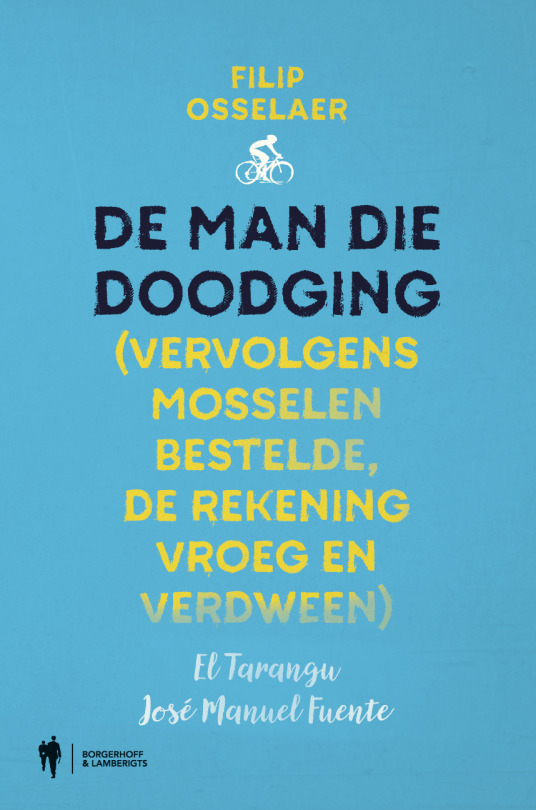
06 johnny vansevenant "1969, het jaar van eddy merckx" (2019)
07 edwin winkels "la vuelta: heroïsche verhalen uit de ronde van spanje" (2019)
08 frederik baeckelandt "fausto coppi (les héros 04)" (2019)
09 harry pearson "the beast, the emperor & the milkman:
a bone-shaking tour through cycling’s flemish heartlands" (2019)
10 peter cossins "the yellow jersey / le maillot jaune" (2019)

11 thijs zonneveld "het panini album" (2019)
12 thijs zonneveld "de fiets, de fiets & nog veel meer sportverhalen" (2019)
13 willy vangenechten "hoe word je een wielerfan (en blijf je er een)?" (2019)
some wissenschaftstompf & autres divertissements ...:
01 robert macfarlane "underland: a deep time journey" (2019)
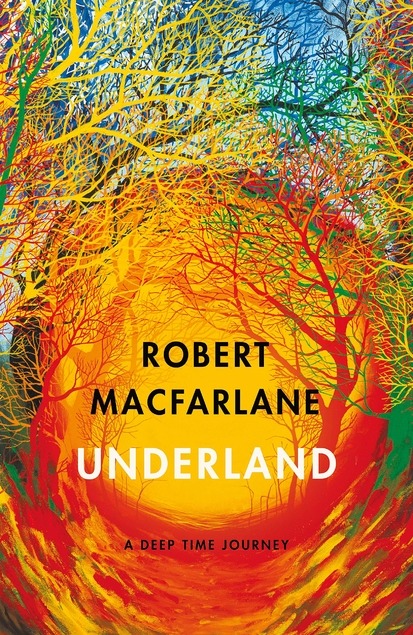
02 george van hal & ans hekkenberg "het kosmisch rariteitenkabinet" (2019)
03 josey waley-cohen "only connect: the difficult second quiz book" (2019)
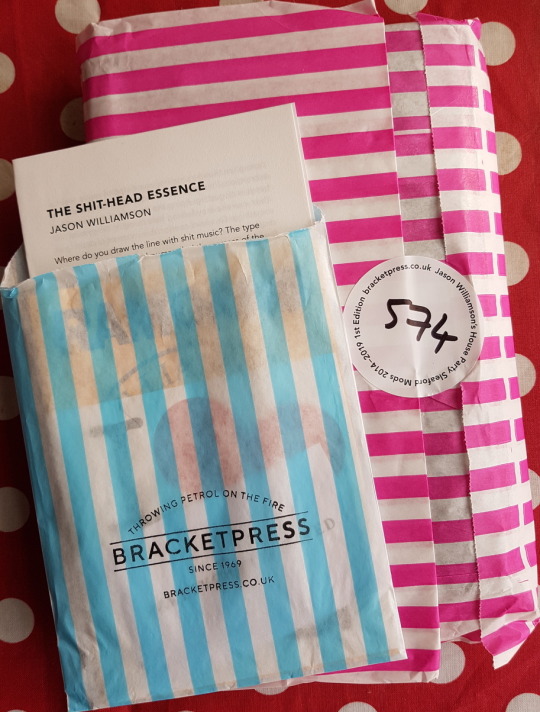
… tsundoku !
may your home be safe from tigers,
leroy,
x
HNY!

... the annual out of control TBR pile ...

postcyberpunkstompf
ada hoffmann "the outside" (2019)
adrian tchaikovsky "children of ruin" (2019)
alastair reynolds "shadow captain" (2019)
+ alastair reynolds "permafrost" (2019)
annalee newitz "the future of another timeline" (2019)
charlie jane anders "the city in the middle of the night" (2019)
farah mendlesohn "the pleasant profession of robert a heinlein" (2019)gareth l powell "ragged alice" (2019)
greg egan "perihelion summer" (2019)
ian creasey "the shapes of strangers" (2019)
jo walton "lent" (2019)

kameron hurley "the light brigade" (2019)
karl schroeder "stealing words" (2019)
megan o'keefe "velocity weapon" (2019)
neil clarke (ed) "the eagle has landed: 50 years of lunar sf" (2019)
nina allan "the silverwind" (2019)
paul di filippo "aeota" (2019)
peter swirski "stanislaw lem: philosopher of the future" (2019)
+ peter swirski & waclaw m osadnik (eds) "lemography: stanislaw lem in the eyes of the world" (2019)
richard kadrey "the grand dark" (2019)
rudy rucker "million mile road trip" (2019)
simon ings "the smoke" (2019)
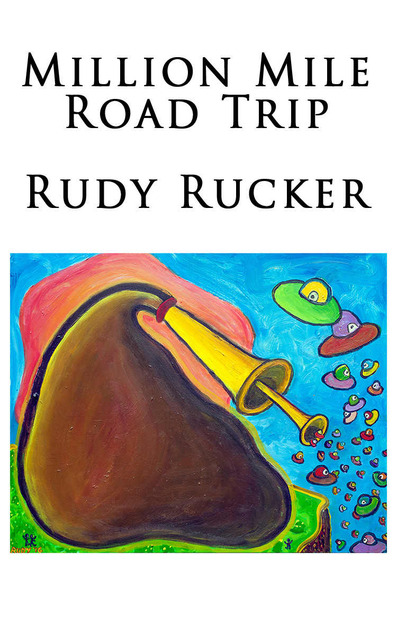
klassikstompf
alex landragin "crossings" (2019)
enrique vila-matas "mac's problem" [2017] (2019)
joseph scapellato "the made-up man" (2019)
kevin breatnach "tunnelvision" (2019)
michel houellebecq "serotonin" (2019)
nell zink "doxology" (2019)
roberto bolaño "the spirit of science fiction: a novel" (2019)
samanta schweblin "mouthful of birds" (2019)
sergio pitol "mephisto's waltz: selected short stories" (2019)
will eaves "murmur" (2019)
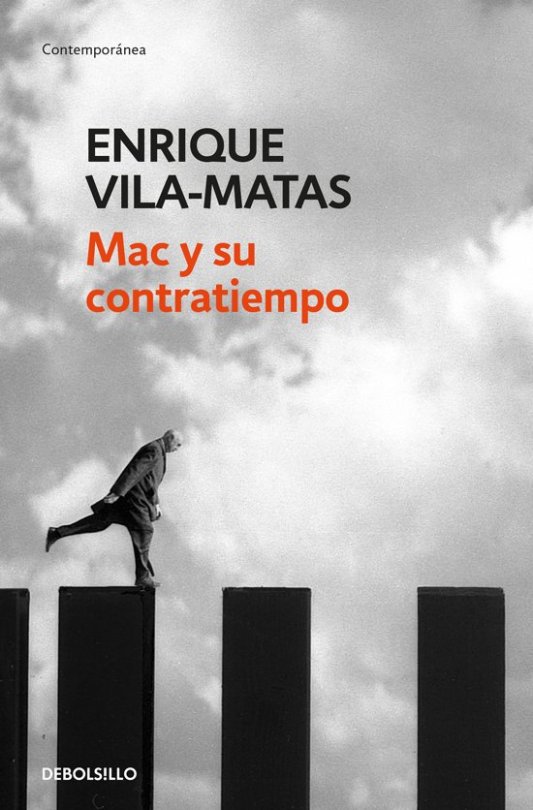
polarstompf
johan op de beek "het complot van laken" (2019)
jon steinhagen "the hanging artist" (2019)
juli zeh "empty hearts" (2019)
max hertzberg "operation oskar" (2019)
+ max hertzberg "berlin centre" (2019)
peter robinson "many rivers to cross" (2019)
tony belloto "bellini & the sphinx" [1995] (2019)

.
.
.
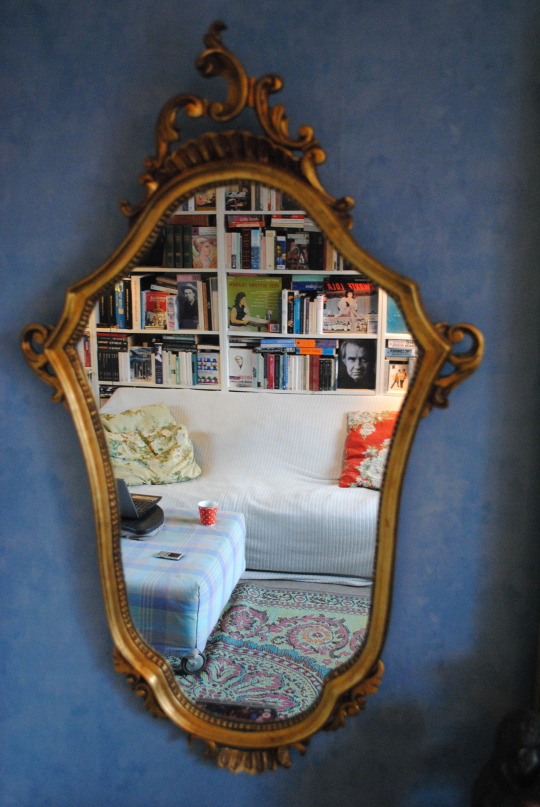
23 notes
·
View notes
Text
EL INSOR Y LAS COMUNIDADES SORDAS: LA NECESARIA DIFERENCIA.

Luis Miguel Hoyos Rojas*
Constitucionalista y Filósofo del Derecho.
Ex Subdirector General del Instituto Nacional para Sordos – INSOR en el Gobierno del Ex Presidente Juan Manuel Santos. Youth Leadership Award 2020 por The Washington Academy of Political Arts & Sciences de los Estados Unidos.
*Articulo de opinión construido a partir del libro: “Comunidad Sorda en Disputa” prologado por Angelino Garzón, Ex Vicepresidente de la República de Colombia y actual Embajador en Costa Rica. Obra original del autor que será publicada por la Editorial Ibáñez.
---
Latinoamérica desconoce en gran medida la filosofía política de las comunidades sordas: El Comunitarismo Sordo. En nuestra región y en especifico, Colombia, se generó la suplantación del Comunitarismo Sordo por los llamados “Estudios Sordos” cuyo soporte científico son los “Deaf Studies” de mediados de los ‘80s.
Los Estudios Sordos son una construcción teórica que ha reducido el “existir constitucional” de los sordos a una “experiencia cultural y lingüística”. Parecen una herencia del posestructuralismo de Derrida, Foucault, Deleuze o Butler.
Estudios Sordos y Comunitarismo Sordo son complementarios, pero desde los “estudios sordos” no se puede plantear una defensa de la igualdad de las personas sordas. Una es la teoría social de la comunidad (Estudios Sordos) y otra la teoría política de su igualdad (Comunitarismo Sordo). Ignorar estas diferencias es abandonar la defensa ilustrada que reivindica que las comunidades sordas no tienen derecho a lo “identitariamente oyente” sino a lo “genéricamente humano”.
El Comunitarismo Sordo es una filosofía política de la igualdad. Nació en la Ilustración y tiene su tronco en los filósofos y educadores franceses: Charles-Michel De l'Épée, Pierre Desgloses, Roch-Ambroise Cucurron Sicard, Jean Massieu y Ferdinand Berthier. Define que los “intereses sordos” están mejor representados en la medida en que sean entendidos como “unión”. Es un igualitarismo semejante al “Feminismo de la Igualdad” que nos enseña Celia Amorós y Amelia Valcárcel.
Como “teoría del poder”, el Comunitarismo Sordo, describe como está organizada la “sociedad oyente” y como las personas sordas unidas entorno a su comunidad pueden incidir para transformar el orden político desigual. Como “Comunitarismo” es el responsable de la aparición de la comunidad sorda como “Comunidad Política” en la Ilustración.
El Comunitarismo Sordo tiene una “periodización” a lo largo de la historia de la democracia moderna. Tiene una genealogía de tres siglos con tres momentos históricos llamados “olas” en los que las comunidades sordas lograron la libertad e igualdad. Se anticipó a la “protección de las comunidades sordas” tres siglos antes que cualquier Declaración o Tratado Internacional que hoy proteja los derechos de las personas con “discapacidad auditiva”. Afirma que la desigualdad entre “sordos y oyentes” no es el problema, pues acepta que “sordos y oyentes” son identidades sociales disímiles. Pero enfatiza que el problema se produce cuando la diferencia se concibe como una “jerarquía política” que subordina a las “comunidades sordas” a la razón de la “perspectiva oyente”.
Cada “ola” del Comunitarismo Sordo generó cambios en las democracias modernas que gran parte de la comunidad sorda desconoce. La primera ola fue el Comunitarismo Sordo Ilustrado. Abarca desde la Ilustración hasta la Revolución Francesa. Fue la polémica que permitió el nacimiento de la libertad política y social de las comunidades sordas en la historia moderna. Gestó el debate sobre la igualdad de la razón sordo-oyente y la defensa de la educación para sordos que inició con De L’Epée y otros en la Ilustración.
La segunda ola fue el Comunitarismo Sordo Incidente que inició con la aparición de la World Federation of Deaf (1951) hasta la década de los ‘80s. Continúa la lucha por la educación para sordos a la que añade otros derechos: lengua y cultura. Por consiguiente, se centró en el acceso a todos los niveles educativos y las políticas públicas sociales. Se potencializó con la “incidencia comunitarista sorda” que generó en el escenario mundial la World Federation of Deaf y el repliegue identitario que la comunidad sorda hizo de otros movimientos sociales para construir su propio camino a la igualdad.
La tercera ola es el Comunitarismo Sordo Contemporáneo, que comenzó a mediados de los ‘90s hasta la actualidad. Inició con el estallido de los estudios sobre comunidad sorda. Nos ha permitido centrarnos en los derechos a la “diversidad sorda”, la “paridad y el papel” de la comunidad sorda en la democracia moderna. Esta última es la más teórica de las tres olas y es a la que debemos importantes cambios. Entre ellos, el cambio del enfoque socioantropológico al enfoque de derechos, aunque también muchos malos entendidos.
El Instituto como casi todas las instituciones estatales para personas sordas en el mundo, aparece en la segunda ola del Comunitarismo Sordo. La aparición del INSOR es resultado de la incidencia comunitarista sorda que en el mundo se alzó con protagonismo a partir de la década de los ‘50s. Un tipo de incidencia que en Colombia, hecha en sus inicios por líderes y pioneros sordos, exigió la igualdad formal (declarativa) ante el sistema político.
Esta incidencia fue inicialmente “institucional” e inició formalmente en la década de los ‘20s y terminó en 1955 con la expedición del Decreto 1955 de 1955 que disolvió a la Federación Nacional de Ciegos y Sordomudos. Sin olvidar que la exigencia de cambios sociales para los sordos era un discurso de la igualdad en Colombia. Fue el trabajo de los “precomunitarismos sordos” liderados por sordos mayores, la Sociedad de Sordos de Colombia (hoy SORDEBOG), entre otros, los que abrieron un camino hacia la igualdad de las futuras generaciones sordas.
Sin embargo, la incidencia comunitaria sorda que permite la aparición del INSOR fue “institucional” porque fue generada al interior de una institución que en esas épocas era una “Federación” compartida con las personas ciegas. No se trató de una incidencia asociativa porque esta no aparece hasta 1984 cuando la construye formalmente, con apoyo de los líderes sordos, la Federación Nacional de Sordos de Colombia – FENASCOL. Que siguiendo el camino comunitarista de la World Federation of Deaf crea una forma distinta de “incidir” a partir de la década de los ‘90s.
La incidencia de la comunidad sorda permite que el Estado se rediseñe: emergen los Institutos Nacionales de Ciegos y Sordomudos, transformados constitucionalmente hoy, en los Institutos Nacionales para Ciegos (INCI) y para Sordos (INSOR). Este logro no se hubiese alcanzado sin la existencia previa de “referentes filosóficos” que permitieron al Estado Colombiano entender que la comunidad sorda es una “comunidad política”. Es así porque el diseño de “instituciones especializadas” para ciertos colectivos está justificado cuando el Estado reconoce que la comunidad que lo demanda es “política” tal como lo explican Walzen y Desgloses. Ese “referente previo”, ha sido desde siempre, el hoy ignorado Comunitarismo Sordo.
El Instituto es un logro institucional de la incidencia sorda. Sin embargo, no es la máxima ganancia política de la comunidad. La máxima será el cumplimiento definitivo de la “agenda igualitaria” que para las comunidades sordas nació en la Ilustración. “INSOR” fue la respuesta que la comunidad sorda esperaba del Estado moderno. Pues un Estado sin inclusión “institucional” para sordos no es ni democrático ni moderno. Por lo tanto, las funciones del Instituto que es Estado, no derivan ni constituyen “incidencia” punto que asimismo merece ser precisado.
La incidencia proviene de la “comunidad política”. Este es el consenso mayormente aceptado en la teoría política moderna. Las comunidades sordas tienen naturaleza “política” desde la Ilustración, esto es irrefutable. Tal como lo reconoció la Corte Constitucional en la Sentencia C-605/12. Es cierto que “INSOR” puede “incidir” en la agenda de los gobiernos, pero tal incidencia no es la que históricamente ha desarrollado la comunidad sorda a través de su Comunitarismo.
Por ello es importante trazar nítidamente un margen diferencial: INSOR no es “comunidad sorda” es una entidad del Estado fruto de la incidencia comunitarista de las personas sordas colombianas. El Instituto es una conquista política del Comunitarismo Sordo Incidente de los ‘50s en Colombia. El Instituto tiene así desde su origen una naturaleza política invariable: un visible brazo del Estado de Derecho extendido para las comunidades sordas del país. Pero al ser Estado no es parte de la comunidad sorda. Sino del sistema político donde también están insertadas las personas sordas como comunidad política.
Lo que erróneamente llaman “incidencia del INSOR” no es tal cosa. El Instituto es ejecutor y asesor de la parte que corresponde a las comunidades sordas en la política de educación e inclusión del Estado. En nuestra tradición jurídica las instituciones públicas de la Rama Ejecutiva no “inciden”. No es ese nuestro diseño constitucional. Las instituciones del ejecutivo colombiano “ejecutan” por medio de políticas públicas los derechos que de distinta naturaleza son reconocidos mediante leyes por el Congreso de la República. La comunidad sorda, representada por la Federación Nacional de Sordos de Colombia – (FENASCOL) es el “movimiento social”, “comunidad política” y “sociedad civil” que incide directamente.
A eso que llaman “incidencia” del INSOR, es mejor llamarle como constitucionalmente es: “Colaboración Armónica”.Establecida en el artículo 113 de la Constitución Política es la que permite que el Instituto concite a instituciones, principalmente públicas, al diseño de una agenda común que progresivamente permita la igualdad sorda como proyecto político. Incidencia y Colaboración Armónica son categorías políticas de la modernidad que definen roles distintos. En mi opinión son fronteras que hoy no se discuten.
Es “deber” de la comunidad sorda identificar por medio la indagación intracomunitaria, las formas de discriminación y opresión que flagelan las realidades sordas. Utilizando la incidencia como mecanismo de diálogo, para mostrar al Estado la imperiosa necesidad de transformar sus realidades. Así mismo, será obligación del Instituto en su naturaleza de Estado, escuchar a las comunidades sordas y propender a la identificación de las categorías políticas que permitan, en asocio con otras entidades responsables, erradicar las principales problemáticas identificadas por las comunidades sordas.
“INSOR” no puede ser “solipsista” pretendiendo construir una agenda política fuera del marco comunitario de las personas sordas. Si puede, en su independencia estatal, planear discrecionalmente la intervención a nivel país. Pero esto es distinto a construir una planeación alejada de la esperanza igualitaria de las personas sordas. Es directamente dar la espalda a la comunidad como principal receptora de la realidad del “día a día sordo”.
El Instituto y las comunidades sordas no deben estar en una suerte disputa técnica. No son equipolentes ni tampoco iguales. Antes de ello, deben insistir en el “diálogo ininterrumpido” pues las comunidades sordas y sus oyentes militantes pueden válidamente informar al Estado de las dificultades que entorpecen el proyecto de igualdad sorda. Que es directamente a donde el Estado colombiano debe apuntar.
Las comunidades sordas deben comprender que, aunque la agenda comunitaria y la agenda estatal tienen causes distintos, hacen parte de una misma geografía política que necesita de acciones coordinadas para lograr la “unidireccionalidad igualitaria” de los sordos. La “desigualdad estructural” que azota a las comunidades sordas necesita de la visión comunitarista de las personas sordas que logra identificarla. Pero aquella requiere de la acción correctiva del Estado para progresivamente erradicarla y esto último es una competencia exclusiva del poder público bajo la proposición del INSOR.
El Instituto jamás debe ignorar que, las comunidades sordas están en constante movimiento. Son bullentes, un movimiento social pacífico que jamás ha derramado sangre en nombre de la libertad e igualdad. Las comunidades sordas tienen autoconciencia cercana de sus fines, a veces por caminos distintos, pero las más preocupadas hacia donde marchan. Lo que en ocasiones pone a las personas sordas “más adelante” que el Estado en el conocimiento de sus particularidades. Solo por esto, que es esencialmente una legítima fenomenología política, el Instituto no puede autoatribuirse la “incidencia sorda”. La incidencia es el mecanismo que desde la Ilustración permite a las comunidades sordas lograr la innovación moral que la democracia moderna necesita para conducir la existencia de las personas sordas de la supervivencia a la “paridad social”.
Otra cuestión importante es la relación entre comunidades sordas y servidores públicos para sordos. Hay otra frontera que inevitablemente se debe recordar: cumplen roles distintos. Unos demandan reivindicaciones para erradicar la desigualdad (comunidades sordas) y otros deben acercar a los ciudadanos sordos al Estado con medidas técnicas y políticas que transformen las realidades desiguales (servidores).
Las personas sordas vinculadas al Instituto siendo parte de la comunidad sorda, cuando ejecutan acciones públicas, no cumplen funciones “comunitarias” sino “legales y constitucionales”. Esto no es hacer “comunidad sorda” sino poner al servicio de las personas sordas el aparato estructural del Estado al que se tiene acceso desde INSOR. Sin embargo, servidores públicos para sordos y comunidad sorda, son militantes del Comunitarismo Sordo. Porque juntos forman parte del mismo propósito constitucional y político: la igualdad de las comunidades sordas.
Todavía hay solapamientos entre INSOR y las comunidades sordas ¿Qué lo genera? La imposibilidad de entender en que consiste la práctica de la política de la diferencia. En una política diferencial coexisten: la representación institucional yla representación civil. La primera es ante los espacios internos del Estado que sería competencia del INSOR. La segunda, ante el Estado y el resto de la sociedad civil, que como sabemos, ha sido asumida legítimamente por FENASCOL. ¿Por qué FENASCOL? porque desde décadas sigue siendo el único “movimiento social sordo” que ejerce la mayor acción comunitarista de representatividad y concertación de las comunidades sordas del país.
La década de los ‘50s es así el momento histórico que comprueba no la existencia de las comunidades sordas, porque ellas ya existían desde la Ilustración. Pero si ratifica que la filosofía política de la igualdad que nació con De l'Épée se manifestó como “incidencia”, una que generó instituciones como el INSOR.
Hoy la incidencia comunitarista sorda tiene otra agenda y vanguardia. Aún sigue la lucha contra la barrera de cristal oyente: un límite social y político que siendo invisible impide a las comunidades sordas el acceso general a la igualdad. Desde de la década de los ‘50s y hasta finales de los ‘90s los sordos incidieron para quebrarla, aunque todavía sigue costando mucho lograrlo. Pero en aquel entonces cuando las comunidades sordas lograron la existencia del INSOR el mensaje a Colombia fue siempre el mismo, el que viene de la Ilustración: “la sociedad democrática sin los sordos no es aún democrática”.
En definitivo, trazar las fronteras entre Estado y Comunidad Política, es una obligación para que el sistema político “modulado” por la comunidad sorda asuma la visión de cómo ha de ordenarse, de cómo ha de ser la sociedad y de cómo tenemos que definir a las personas sordas: libres e iguales. Para recordar la imperiosa necesidad de tomar conciencia de que la comunidad de sordos es más que cultura y lengua: que ser “sordo” es una diferencia genéricamente humana.
---
*Doctorando (PhD) en Derecho en la Universidad Carlos III de Madrid (España). Ex Asesor, Secretario General y Subdirector General del Instituto Nacional para Sordos— INSOR— Profesor Investigador en Derecho Constitucional Económico, Teoría Feminista y Justicia Constitucional. Abogado de la Universidad del Norte (Colombia) con estudios de Maestrías en Derecho, Derecho Constitucional y Ciencia Política en la Universidad de Harvard y el Centro de Estudios Políticos y Constitucionales de Madrid. Miembro extranjero de la Asociación Argentina de Derecho Constitucional (AADC), ATITLAN-CEPC (Madrid, España) y Objetores del Patriarcado (Colombia). Par evaluador del Observatorio Colombiano de Ciencia y Tecnología (OCyT), Asociación Colombiana para el Avance de la Ciencia (ACAC) y del Ministerio de Ciencia, Tecnología e Innovación de Colombia. En 2019, Visiting Research Professor en el Tribunal de Justicia de la Unión Europea—TJUE (Luxemburgo) y el Instituto de Bienes y Políticas Públicas—IPP del Gobierno de España (Madrid).
1 note
·
View note
Text
Allons zoo-musée ! Astuces pour dessiner les animaux avec Justine
Atelier pour les enfants à partir de 2 ans, accompagnés d’un adulte, et les familles
Le Louvre-Lens est peuplé de nombreux animaux…
Oh ! oh ! mais attendez ! C’est un musée ou un zoo ?
C’est un musée bien sûr mais on peut y voir beaucoup d’animaux. À votre avis, est-ce que ce sont de véritables animaux ?
Ah non évidemment ! Ce sont des animaux peints, sculptés ou dessinés. Il y a même des animaux étranges, qui n’existent que dans l’imaginaire.
Allons à leur rencontre avec quelques images.
Pour réaliser cet atelier, vous aurez besoin d’un crayon à papier, de plusieurs feuilles de papier et de quoi mettre en couleur vos animaux : crayons de couleur, feutres ou peinture.
Pour chaque animal, vous utiliserez votre main comme gabarit, un modèle dont vous dessinerez le contour.
1 - Le chat
Miaou ! A l’entrée de la Galerie du temps, on entend doucement ronronner. Voici Bastet, sous sa forme de chatte. Il y a 2500 ans, les Égyptiens la vénéraient comme déesse protectrice de la maison et des enfants.

Égypte
La déesse Bastet sous sa forme de chatte
Vers 650-350 avant J.-C.
Bronze, yeux en cristal de roche
https://www.louvrelens.fr/work/deesse-bastet-forme-de-chatte/
Photo © RMN-GP (musée du Louvre) / Georges Poncet
Pour réaliser le chat, je sers le poing et je sors l’auriculaire et l’index.

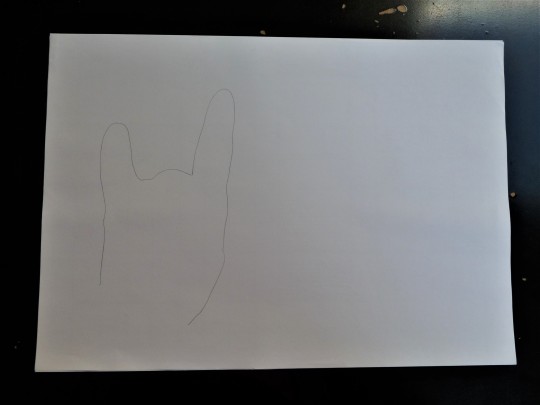
Je dessine ensuite un petit nez en forme de triangle, deux petites cannes recourbées pour la bouche et deux jolies amandes pour les yeux. Sans oublier les moustaches.
Si vous avez de la place, vous pouvez dessiner tout le corps de votre chat.
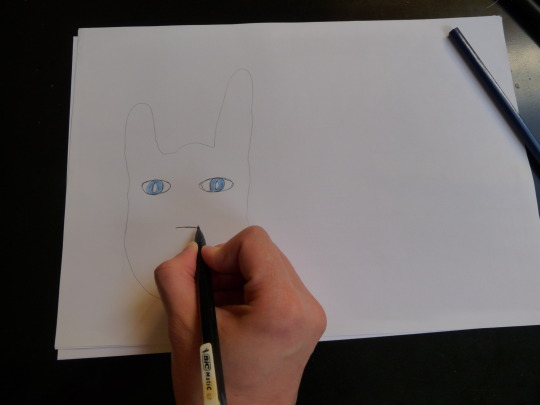
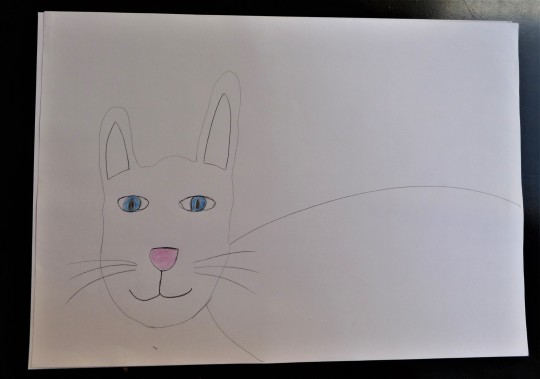
2 - Le lion
RRRRRRROAAAH ! Oh! mais qu’est-ce qu’on entend ? Le rugissement d’un lion ! Voici un relief décoratif venu d’un royaume lointain...
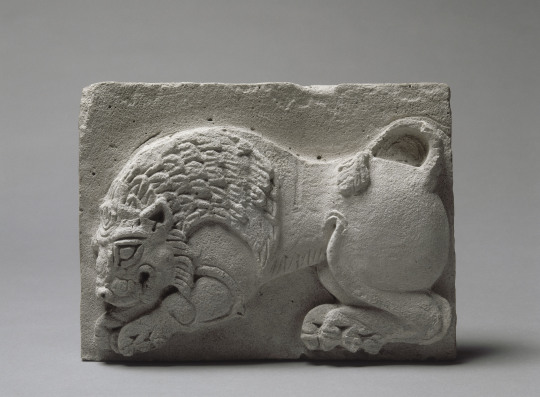
Iraq (?)
Élément de décor d’un bâtiment d’époque sassanide : lion bondissant
Vers 500-600
https://www.louvrelens.fr/work/element-de-decor-dun-batiment-depoque-sassanide-lion-bondissant/
Photo © RMN-GP (musée du Louvre) / Franck Raux
Pour dessiner le lion, je reprends le modèle du chat, mais je lui ajoute une belle crinière !


3 - Le chacal ou le loup
Juste à côté de Bastet, dans la Galerie du temps, on voit un coffret : une petite boîte, sur laquelle sont dessinés plusieurs dieux dont, sur les côtés, Anubis. Le dieu des morts est peint sous la forme d’un canidé couché, on dit souvent que c’est un chacal, c’est-à-dire un animal qui ressemble à un loup.

Égypte
Coffret à troupe de serviteurs funéraires (oushebtis)
Vers 1296-1069 avant J.-C.
Bois peint
https://www.louvrelens.fr/work/coffret/
Photo © RMN-GP (musée du Louvre) / Christian Decamps
Pour réaliser le chacal, je pose ma main à plat, les doigts fermés et le pouce sorti.

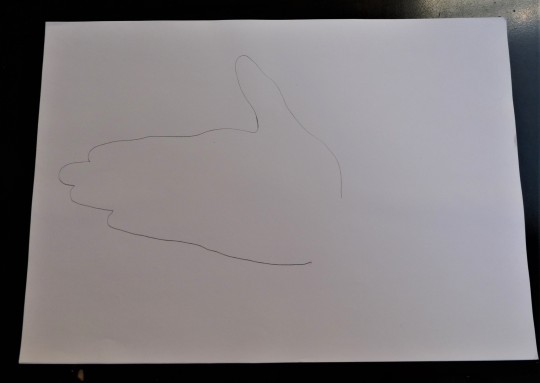
J’ajoute une deuxième oreille, un œil et surtout des dents acérées.
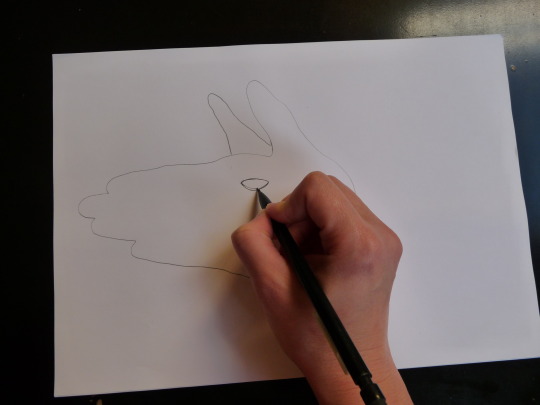
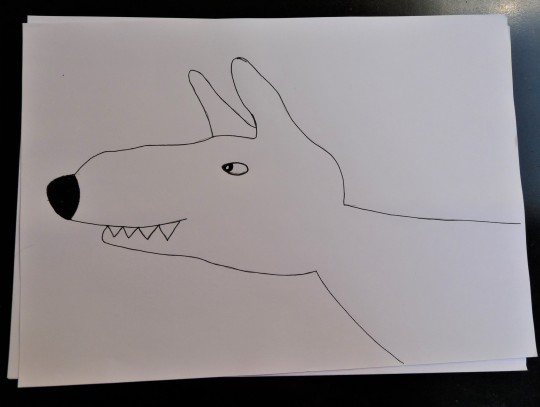
4 - La Victoire
Oh! mais que voilà une étrange créature ! Regardez cette petite sculpture, une jolie jeune femme munie d’une paire d’ailes. Elle représente la Victoire.
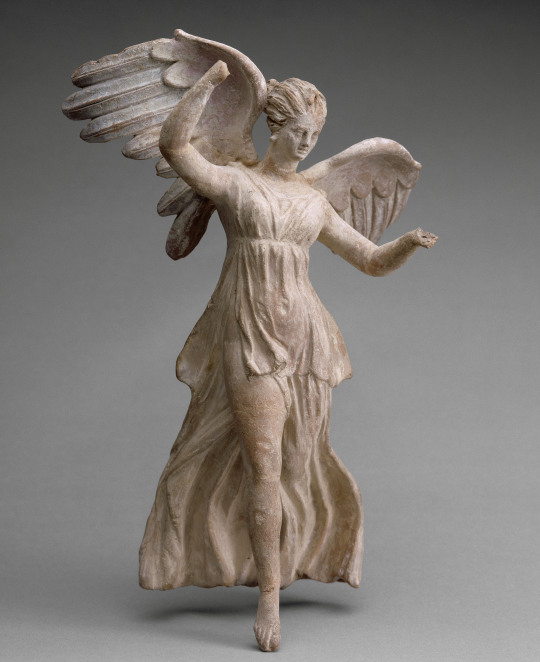
Myrina, Asie mineure (Turquie actuelle)
Jeune femme ailée : Niké, personnification de la Victoire
Vers 190 avant J.-C.
Argile
https://www.louvrelens.fr/work/jeune-femme-ailee/
Photo © RMN-GP (musée du Louvre) / Hervé Lewandowski
Pour dessiner la victoire, je pose une main à plat les doigts bien écartés. Puis je pose l’autre main à côté.

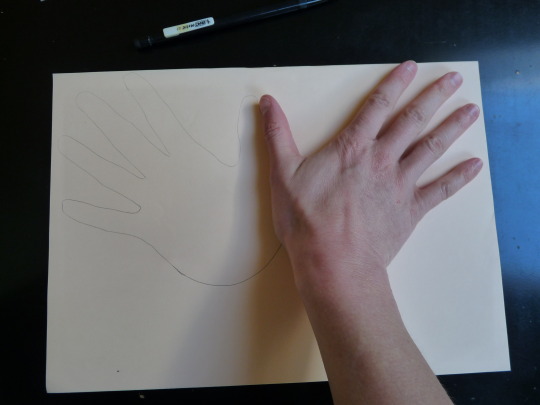
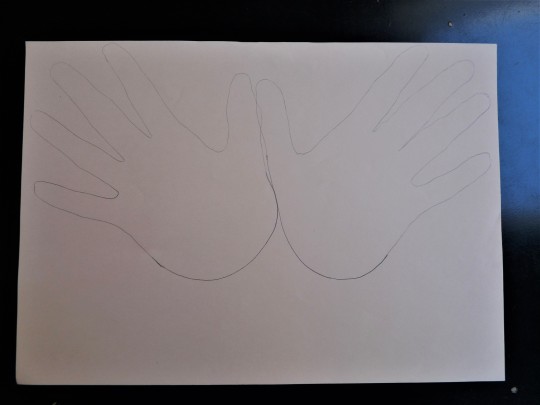
Je gomme les deux pouces.
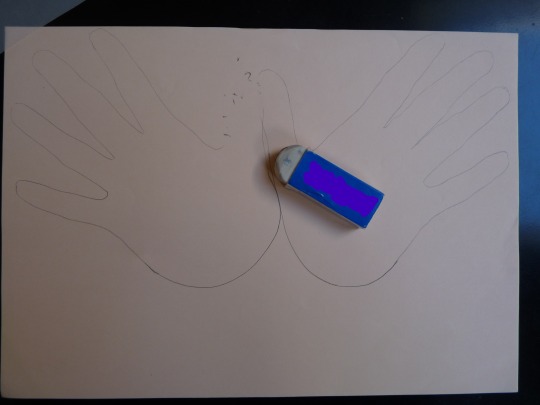
Entre les deux mains, je dessine la Victoire sous les traits d’une jeune femme. J’ai choisi de la décalquer, mais tu peux la dessiner à main levée !

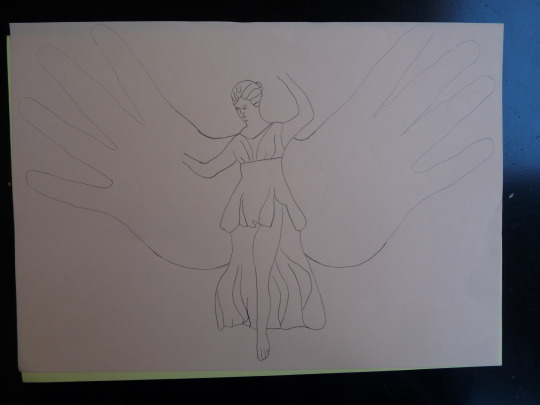
5 - Le perroquet et les oiseaux
Tendez l’oreille à nouveau. On entend les chants des oiseaux… En avançant dans la Galerie du temps, on trouve une table faite de pierres multicolores. Observez-la bien, on y voit un foisonnement de fruits et de fleurs sur lesquels sont perchés des perroquets et d’autres oiseaux.
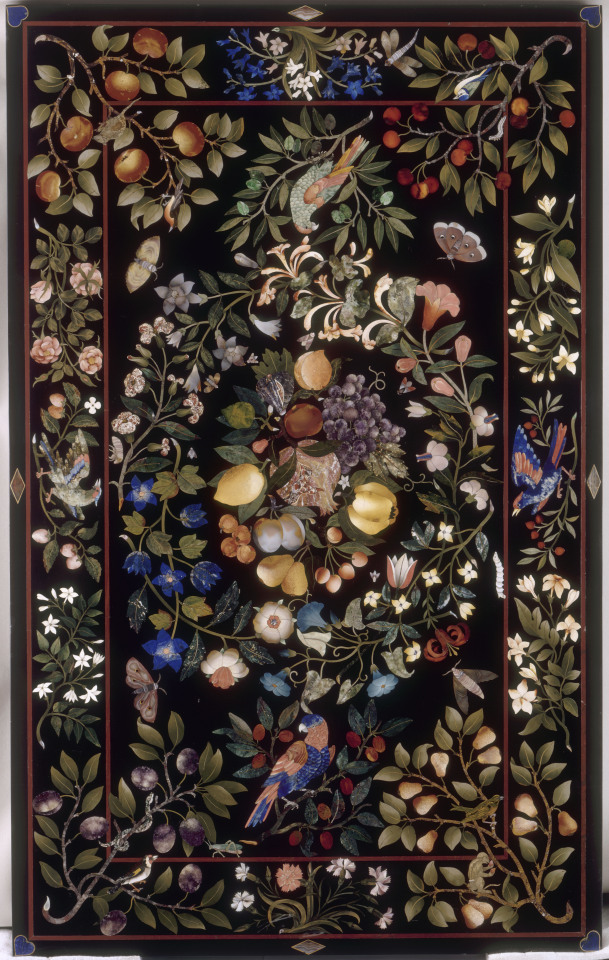
Florence, Italie
Plateau de table à décor floral
1668
Mosaïque de marbre et pierres dures
https://www.louvrelens.fr/work/plateau-de-table-a-decor-floral/
Photo © RMN-GP (musée du Louvre) / Jean-Gilles Berizzi
Pour dessiner le perroquet, je pose ma main à plat, les doigts fermés, le pouce légèrement sorti. Puis je place la feuille à la verticale.
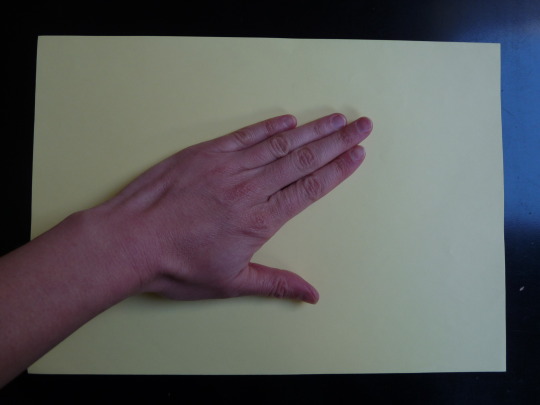
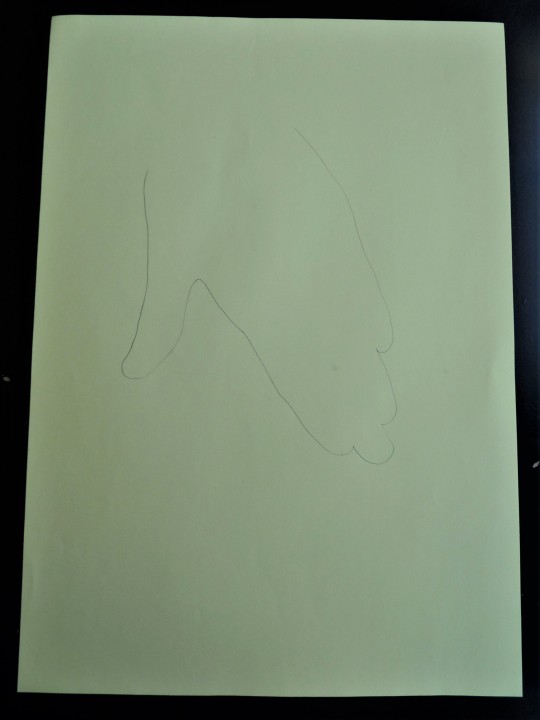
Je ferme le dessin de la main pour dessiner une tête et je redessine les doigts. Puis j’ajoute un bec et un œil, une deuxième patte, une aile et une queue aux belles plumes multicolores.
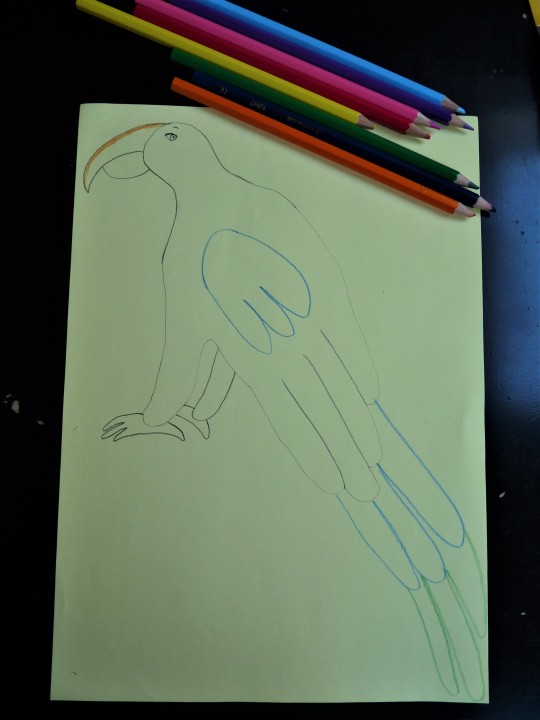
Pour les autres oiseaux...
Oiseau n° 1 : l’oiseau posé
Je pose ma main à plat, tous les doigts bien écartés.

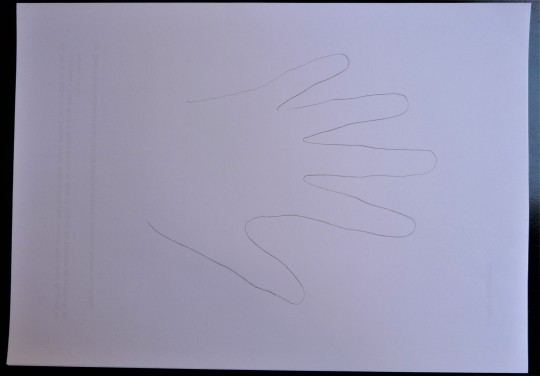
Je referme le dessin en créant une tête bien ronde. J’ajoute le bec et l’œil, je trace une aile au milieu du dessin de la main et deux petites pattes au niveau du pouce.
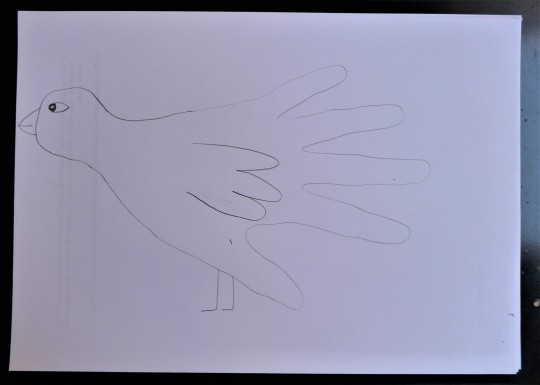
Oiseau n°2 : l’oiseau en vol
Je pose ma main à plat, l’auriculaire et le pouce bien écartés, tous les autres doigts serrés.
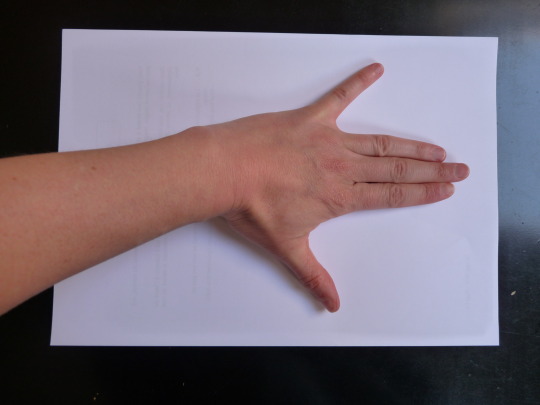
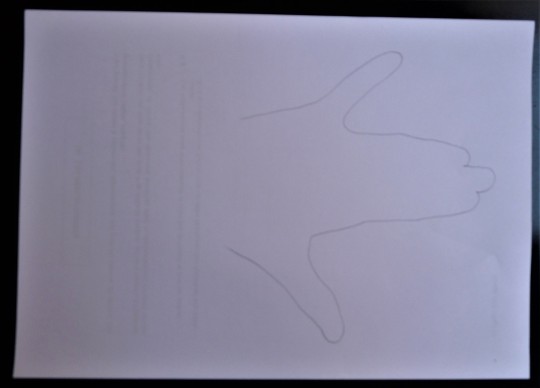
Je ferme le dessin en dessinant, là aussi, une tête toute ronde. Puis le bec et l’œil. J’ajoute des traits à la base du pouce, de l’auriculaire et des autres doigts, cela me servira à colorier les ailes et la queue de l’oiseau. J’ajoute des petites pattes entre le pouce et l’index.

Oiseau n°3 : l’oiseau aux ailes déployées
Je pose ma main à plat, tous les doigts biens écartés.
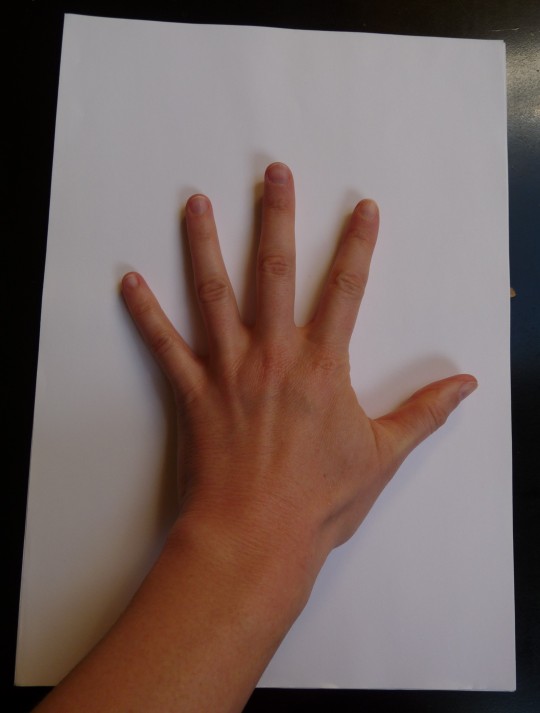
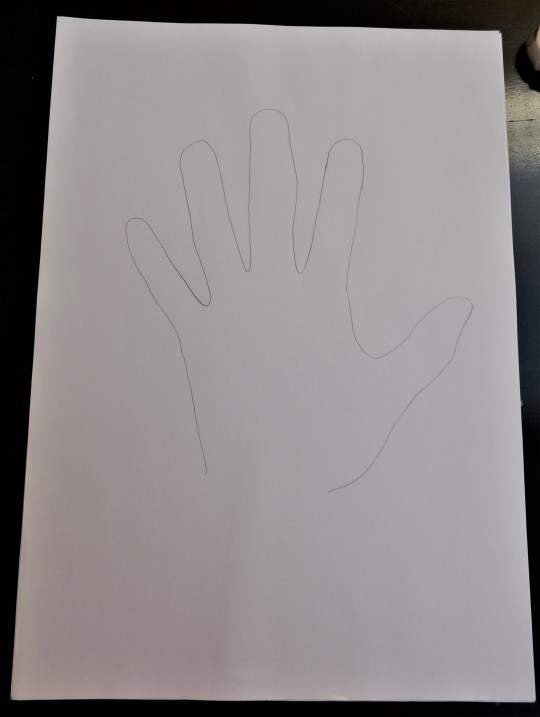
Je ferme la main par un arrondi. Je dessine sur le pouce un œil et le bec. J’ajoute une queue de plumes et des petites pattes.

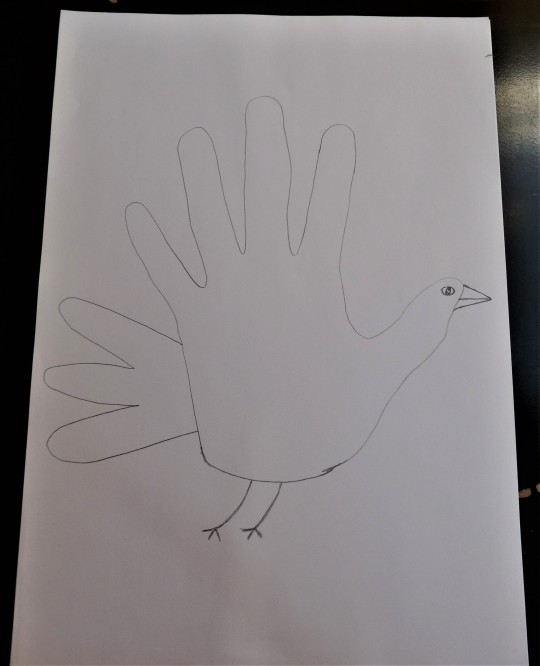
Bonus
Et en bonus, parce que je les aime bien, voici des animaux qui ne sont pas au Louvre-Lens mais qu’on trouve dans certains musées : tu as peut-être déjà vu leurs squelettes... Je te propose d’apprendre à dessiner... des dinosaures!
Le diplodocus
Je place ma main à plat, l’annulaire et le majeur écartés, le pouce légèrement sorti. Je retourne la feuille, je referme le dessin de la main et je dessine les doigts. J’allonge le pouce pour créer une longue queue et j’ajoute un long cou.


Je dessine un visage souriant, deux petits yeux et un sourire. Je dessine des petits triangles sur le dos pour créer une crête.
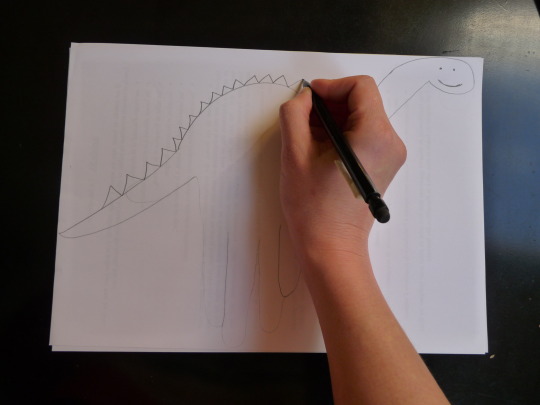

Le Tyrannosaure (surnom : T-Rex)
Je place ma main à plat, l’annulaire et le majeur écartés, les autres doigts serrés. Je dessine un œil au bout du pouce, un corps allongé avec une queue, de petites pattes avant et des pattes arrières plus grandes, et une crête sur le dos. Et surtout je n’oublie pas les dents pointues !

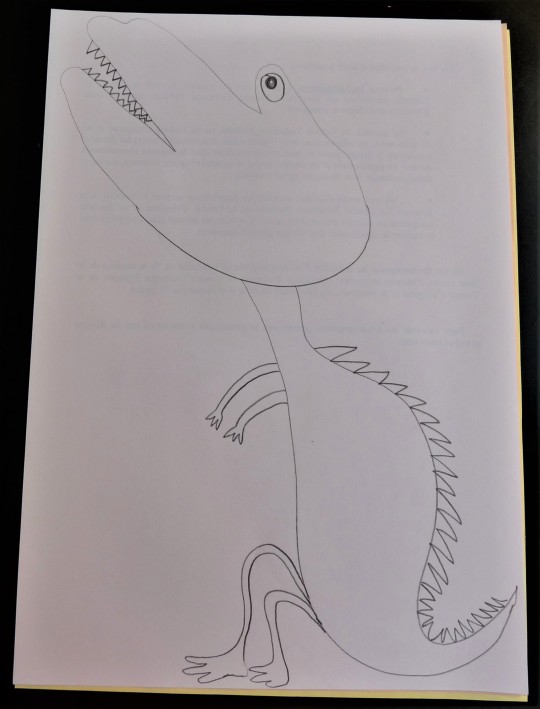
#Tutos#Animaux#Dessin#Coursdedessin#chat#lion#Anubis#Victoire#Oiseau#Louvrelens#culturecheznous#Culturechezsoi#MuseumFromHome
1 note
·
View note
